Recipe for a podcast success
Recipe for a podcast success
Svenska Dagbladet’s podcast series on the Stenbeck family of financiers was an experiment in more ways than one. But the gamble resulted in the newspaper’s most successful publication to date. Producer Adam Svanell tells the story.
By Adam Svanell
Tom Henley, Hugo Lavett, Jan Almgren (in the back), Lovisa Lamm Nordenskiöld and Adam Svanell worked together on SvD:s podcast series Dynastin.

Recipe for a podcast success
Svenska Dagbladet’s podcast series on the Stenbeck family of financiers was an experiment in more ways than one. But the gamble resulted in the newspaper’s most successful publication to date. Producer Adam Svanell tells the story.
By Adam Svanell
The idea didn’t come from some decision taken at senior management level or some brainstorming session; it came during a coffee break. In the autumn of 2021, I was working as long read editor for Svenska Dagbladet and had invited Lovisa Lamm Nordenskiöld and Robert Barkman from the production company Banda to give an inspirational talk. At SvD we wanted to focus more on audio stories in some form or other but didn’t know exactly how we should go about it. The idea was to start with Lovisa and Robert holding a basic course in the do’s and don’ts of radio journalism to a group of selected reporters.
I had assumed that the younger reporters would be especially enthusiastic about getting the chance to learn something new, but it turned out that Jan Almgren, an experienced business journalist approaching 60, was the one who asked the most questions. During a break, while Lovisa stood by the coffee machine, Jan piped up: “I’d like to do a podcast from the business world. There are loads of good stories there,” he said. Lovisa was quick to respond: “Absolutely. Who wouldn’t want to hear a documentary about the Stenbeck family, for instance?” I don’t want to exaggerate how dramatic that moment was, but something in the room shifted. I guess everyone sensed what an incredibly good idea it was.
The monopoly buster
The Stenbecks are one of Sweden’s wealthiest, most powerful and most secretive families. They’re more colourful than other families of financiers, but they’ve also been plagued by drug abuse, open power struggles and premature deaths. Several books had already been written and documentary series made about Jan Stenbeck, the mythical American-style entrepreneur who had been one of Sweden’s most controversial figures in the eighties and nineties. The monopoly buster. The man who brought commercial TV and the consumer mobile phone to Sweden, even though they weren’t actually allowed. But there was another story, one that wasn’t as well known: the one about Jan Stenbeck’s American-born children. They had barely reached adulthood when their father died of a heart attack in the summer of 2002, leaving them with a hugely successful empire.

Sophie Stenbeck with one of the horses at her ranch in Wellington, Florida, March 9 2022.

Sophie Stenbeck with one of the horses at her ranch in Wellington, Florida, March 9 2022.
They seemed to be characters straight out of a Shakespeare play. Cristina Stenbeck, the eldest child, who assumed her father’s mantle as head of both the family and the business empire and became one of Europe’s most powerful businesswomen. Hugo Stenbeck, the wayward son who made headlines for bar brawls and drunk driving. Sophie Stenbeck, the more sensitive sister who was involved in charity work and was referred to as “the family’s Mother Teresa.” Max Stenbeck, his father’s favourite child, the charming little brother who was predicted to take over the family business one day but who instead died at the age of 30. And then there was Felix Granander, the “unknown son,” whose existence his half-siblings knew nothing about until their father’s death.
Like all genres, Swedish podcasts and radio documentaries have certain methods and conventions. They revisit a historical news event, portray a person as either eccentric or as someone who met a tragic fate, or they sniff out some kind of mystery. A lot of documentaries look like that. What appealed to me with this idea was that it had the potential to be something different; a cross between a business story and a family saga. More like a TV drama, where the audience follows a given cast of characters over time.
Well, there’s no denying the insatiable curiosity about the rich and powerful.
Of course, other journalists had tried to portray the Stenbeck siblings, but they had done so from the outside and from a distance. If we were going to do it, we would do it from the inside.
Jan and I had a meeting with the production company Banda and agreed on a plan: if we could get one of the Stenbeck siblings to participate, we would make a documentary series together. If we managed to get two of them to do interviews, the series had the potential to be really good. We began by approaching Sophie Stenbeck because she seemed to be the sibling that would most likely consider the proposition. In her youth, she was known for shying away from the spotlight, but in recent years she had done a couple of interviews. Maybe she had changed her view of the media? It was worth investigating.
Agreed to an interview
So one morning in March 2022, Jan and I drove to Sophie’s equestrian centre in Wellington, Florida. She had agreed to give us three whole days of interview time. But we were nervous; we had no idea whether she would actually tell us anything of substance or just answer our questions politely, superficially and evasively like a media-trained person of power.
As it turned out, Sophie Stenback was more than ready to talk. She spoke with astonishing candour about everything from the power struggles within the family empire to the deaths of her father and brother. When Jan and I drove away from the equestrian centre after conducting the first day of interviews, we were so excited that we screamed out loud.
The work continued after the Florida trip. Jan approached more people for potential interviews and I began editing the material recorded on our trip. Everything felt good, we were just about home and dry – or so we thought. In actual fact, we had a long and strenuous process ahead of us. For one thing, we had made some mistakes. One example among many is when Jan interviewed Lars Johan Jarnheimer, spokesperson for Ikea’s holding company and an extremely busy man. When the one-and-a-half-hour interview ended, Jan glanced at the audio recorder and realised he had forgotten to turn it on. He was forced to grovel until Jarnheimer finally agreed to do the whole thing over again from scratch.
A crucial participant
But what concerned us most was the time it took for the other three siblings to reply. Although Cristina Stenbeck said no to taking part almost immediately, we still held out hope that Hugo Stenbeck would agree, but his spokesperson finally informed us that he declined. The fact that Felix Granander, “the unknown son,” hadn’t replied at all made the situation even more stressful.
Hugo and Cristina had always been close to Sophie, and in our interviews, she had also talked a lot about their life experiences. But Felix had grown up far away on the other side of the Atlantic and had led a turbulent life. Only he could tell his story.
Finally, after many months of waiting, Felix informed us that he would participate. He gave us three long interviews in which he talked open-heartedly about his drug abuse problem and the grief he felt for the father he never got to know. He also revealed that he didn’t know, and hadn’t even met, his half-siblings Cristina and Hugo.
Back to the drawing board
Jan and I then wrote and edited this into a documentary series in six episodes, telling a story that played out over two decades, from Jan Stenbeck’s sudden death in 2002 to his daughter Cristina’s abdication as head of the business empire in the early 2020s. We played the episodes for Lovisa Lamm Nordenskiöld and her colleague Hugo Lavett in Banda, thinking that the series was more or less completed. But they didn’t agree; we had told the story in the wrong sequence, they didn’t sympathise with the siblings when they listened to them, and they found it difficult to follow when the life stories of the father and the five children were presented simultaneously. We had to go back to the drawing board.
After a long delay, the series, called Dynastin (The Dynasty), was finally released in January 2023. For us at Svenska Dagbladet, the publication also proved to be a real experiment. Previously we had released our bigger podcast projects free of charge on all the regular platforms like Spotify, Apple Podcaster and Podme. People with experience from the podcast industry had told us that it was hard to charge for podcasts and that audiences are rarely prepared to use podcast apps other than the ones they use for their regular podcasts.
But this time we decided to take a chance. We decided to publish the first two episodes on all platforms but to make the four remaining episodes available only on Svenska Dagbladet’s own site and to paying subscribers. We had no idea whether it would work; we were running the risk that people might be content with hearing the two free episodes. But if that happened, we always had the option of releasing the rest of the series free of charge later.
Most successful publication
As it turned out, we had worried in vain; at the time of writing, Dynastin has drawn over 600,000 listeners. Every fourth person who heard the two free episodes chose to go to SvD.se to continue listening. In fact, the number of subscriptions sold beat Svenska Dagbladet’s previous record by a huge margin. The series has attracted attention in lots of TV and radio programmes, podcasts and newspapers. In terms of both conversion and reach, it’s SvD’s most successful publication to date.
When you write a text like this one, you’re expected to offer some kind of recipe for success, some explanation of why it went so exceptionally well. So what do I think? Well, there’s no denying the insatiable curiosity about the rich and powerful.
Because Sophie Stenbeck and Felix Granander decided to speak out, we could give a unique insight into a family which previously had kept a very low profile. But I don’t think that insight would have had the same impact if it had not been presented with sound narrative craftsmanship, without a script that was honed time and time again and without Jan Almgren’s skilful investigation into the family’s business empire. Also, without Jan’s experience and reputation capital, many key figures would never have taken part and spoken as candidly as they did.
For me, as a podcast creator, the project sparked a desire to dare to experiment even more with methods and genres. It was a reminder that you shouldn’t have too much respect for the “truths” you hear from experts. And not least, Dynastin has proved that these types of ambitious documentary projects are not just journalistically relevant and good for a brand; in the best-case scenario, they can also be good business.
[Sassy_Social_Share]
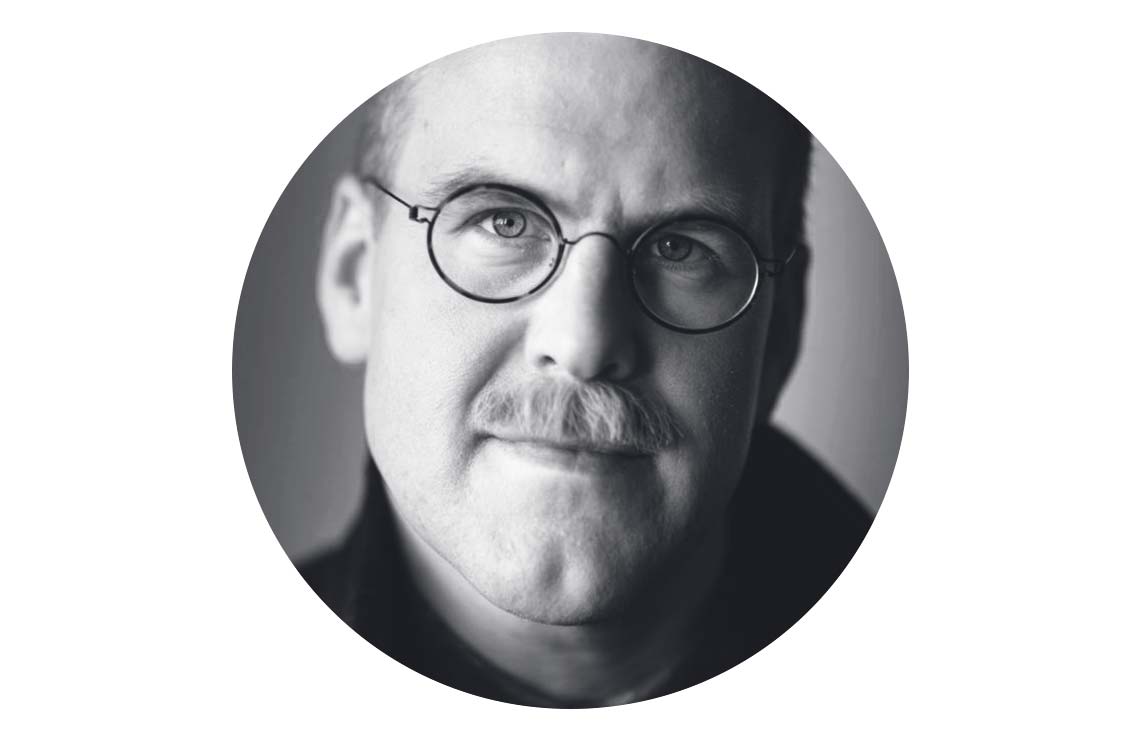
Adam Svanell
Head of Documentary, SvD
Years in Schibsted: 11
My favourite song the last decade: Mam Yinne Wa – Alogte Oho & His Sounds of Joy
How culture can help you reach your business goals
How culture can help you reach your business goals
People and culture are the most important assets in every successful company. But how can you actively lead culture in the direction that supports your business and gets you where you want to be?
By Enna Kursukangas

How culture can help you reach your business goals
People and culture are the most important assets in every successful company. But how can you actively lead culture in the direction that supports your business and gets you where you want to be?
By Enna Kursukangas
Without people, companies would be empty. And without a consciously driven culture, it’s hard to harness the full potential of an organisation and deliver the results the company aims for. But how can we define what culture is?
There are plenty of suggestions out there. My favourite is one of the simplest ones I’ve heard: “It’s what happens when no one is watching.” Culture is what we do, it’s about our habits, our values and the unwritten rules that affect our actions. On a more practical level, the things that help us to build a culture include the way we lead, how we set targets and prioritise, how we organise ourselves and so on.
Culture develops every day
Everything we do and don’t do affects our culture, and on the other hand, our culture affects how we do things. Culture is not something that changes overnight; it’s something that continues to develop every day.
Over the past 20 years, I’ve worked in companies of different sizes, different industries and different business situations. I’ve learned that no matter if it is a startup, a huge corporation, or a company in growth or decline, some things have proven to be universally relevant when talking about the importance of a culture and how to build it. Here are my key learnings on why culture is so crucial to all companies.

Everything we do and don’t do affects our culture, and on the other hand, our culture affects how we do things.

Everything we do and don’t do affects our culture, and on the other hand, our culture affects how we do things.
There is always a culture, no matter what we do about it. But by making conscious decisions, we can have the kind of culture that enables us to get to where we want to be.
Company strategies tell us where to go, and culture makes sure we get there. Culture is a tool for a company to achieve what it’s after. It’s never a destination, but without actively leading culture, it’s much harder to get to the intended destination.
It’s in your goals
Everything we do represents the culture we have. It’s not soft. It’s not hard. It’s all that and everything in between. It’s in your goals, it’s in your walls, in your websites and in your daily decisions. It’s present when you hire as well as when you need to fire. You can’t separate the culture from anything you do. It affects your actions, and every action affects your culture.
It’s easy to see why culture is an important asset and something you should actively lead within your organisation. But how do you do that? How do you take control of something so organic and something that is so hard to measure? The truth is that you can’t control it, but you can, and you should, actively lead it in the direction that helps your business get to where you want to be.
You should be loud about what kind of culture you aim for and co-design the structures that help you achieve it.


You should be loud about what kind of culture you aim for and co-design the structures that help you achieve it.
Discover your current culture. To take an active role in leading culture, it’s best to start with understanding the current culture and what it is that you want to achieve as a company. And the best way to get to know your culture is by observing it and gathering different views on it. This should be ongoing work within the company, especially if you have a change need. At these times, it can be useful to seek external support to capture your current culture. Since all employees are part of the culture, it might be hard to see the unique traits you have within that culture from the inside.
Define what kind of culture you need and want. To take steps in this cultural journey, we need to define what kind of culture we need to achieve our goals. When defining, there are two important things to take into consideration. First, it’s hard to build a strong culture that attracts everyone. And there is no need for that either. Targeted culture should be built for the talents you need for your business to succeed. Second, culture is a tool to get to where you want to go, so make sure that what you define as your target culture, actually ensures you reach your business goals.
A roadmap
Be loud about what kind of culture you aim for and co-design the structures that help you achieve it. You might need a roadmap of initiatives to show the cultural change ahead and how to include people in this cultural work. But don’t trick yourself into believing that cultural change is something you can make happen using only flow charts, project plans or workshops. Instead, use the roadmap to illustrate the change you are leading and to get people on board.
Culture is hard to capture, which is why it’s even more important to focus on concrete initiatives, active communication and dialogue within the organisation. The right initiatives always depend on where the organisation is and what it aims for, but company values, a leadership framework and manager role definitions are concrete cultural building blocks that are helpful.
In Schibsted Nordic Marketplaces, we are in the middle of a major transformation, moving from country-based organisations to a cross-Nordic verticalised organisation. To enable this change, we focused on building a common culture across the Nordics and we co-designed four common values for Marketplaces:
- Make a difference
- Be curious
- Be fearless
- Win together
These values represent what unites us across countries, but also how we work together to really add value for our users, customers and co-workers. And how we build sustainable futures and create success on this shared journey. These values form a strong base for our common culture across the Nordics and they guide our behaviours, decisions and actions. These values give us the strength to lean into our transformation journey, because by continuing to be curious, staying fearless and focusing on winning together, this transformation will happen, and we will make a difference.
[Sassy_Social_Share]

Enna Kursukangas
People & Culture Director, Schibsted Nordic Marketplaces
Years in Schibsted: 3
My favourite song the last decade: Cha Cha Cha – Käärijä
As the tiger leaves the scene – there is room for curiosity
As the tiger leaves the scene – there is room for curiosity
The venture capital market is going through a profound change. From extreme economic volatility to a demand for profitable growth. In a conversation, Andrew Kvålseth, Schibsted´s CIO and EVP of Growth and Investments, shares his view on what this means and how Schibsted is focusing on investing closer to core.
By Nathalie Kåvin
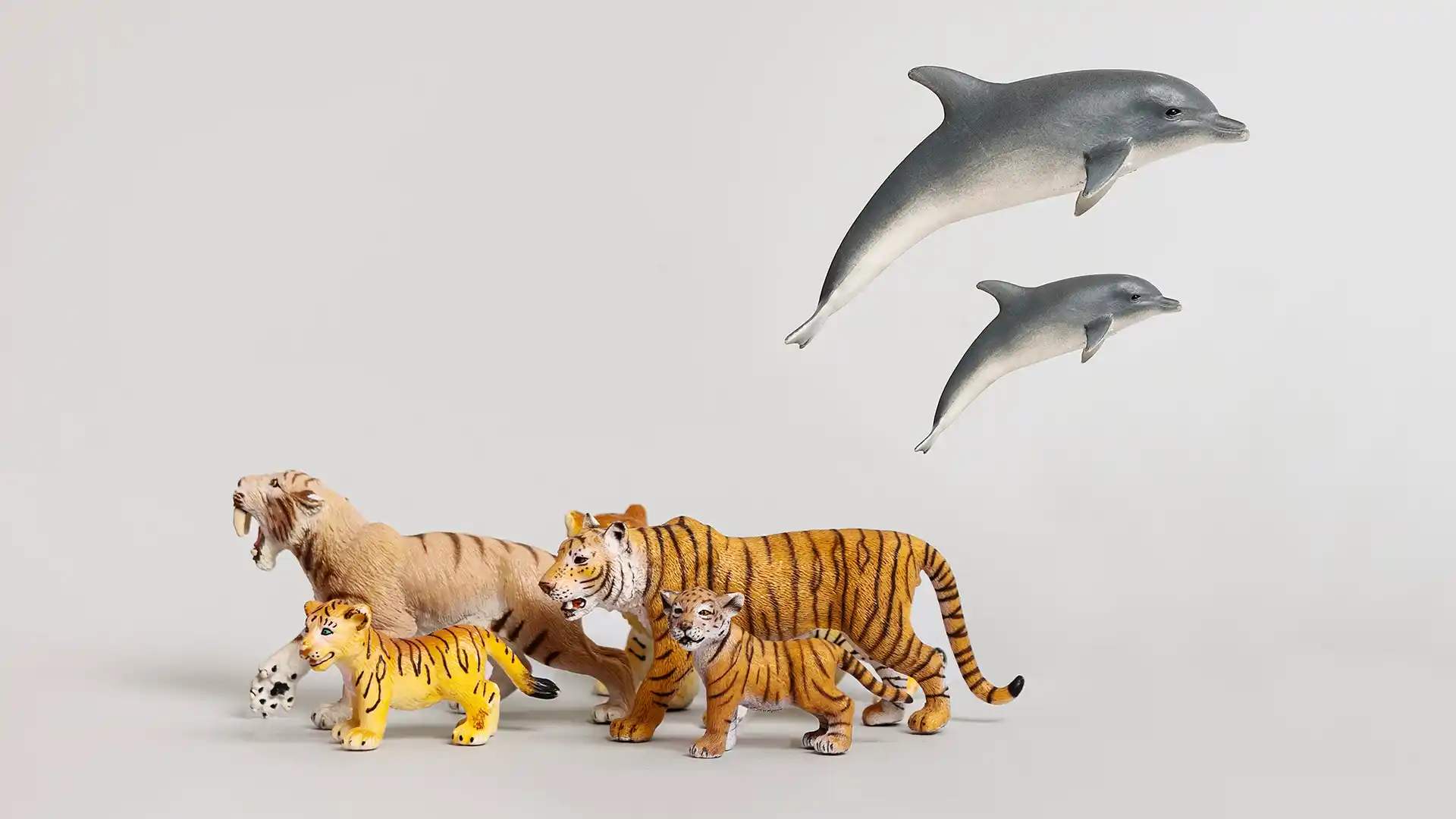
As the tiger leaves the scene – there is room for curiosity
The venture capital market is going through a profound change. From extreme economic volatility to a demand for profitable growth. In a conversation, Andrew Kvålseth, Schibsted´s CIO and EVP of Growth and Investments, shares his view on what this means and how Schibsted is focusing on investing closer to core.
By Nathalie Kåvin
In Schibsted Future Report 2022, a previous colleague wrote an article on what was defined in the VC world as “The Year of the Tiger.” At that time venture capital was booming. In the third quarter of 2021, a whopping 158.2 billion USD was invested into startups at various stages, according to CB Insights. This was more than double the investment compared to the third quarter of 2020. As recently mentioned by Asset Class, however, the influx of capital, coupled with readily available leverage, led to a booming era of dealmaking while sending asset prices and company valuations to record highs.
After three years of extreme economic volatility, the world and VC economy look quite different. As described in a recent article in TechCrunch, venture deal volume has fallen every quarter since Q2 2022 across the world, and the trend shows no signs of reversing.
A repricing of risk
So, what key impacts have these dramatic changes had on the global VC markets?
Andrew Kvålseth starts our conversation by explaining why we now are at a place where the market value companies vastly different than in the “years of the tiger.”
“Most importantly – we’ve seen a repricing of risk,” he says. “When interest rates were near zero, it mattered less whether or not you earned a million dollars today or a million dollars five years from now. This put a tremendous focus on gaining scale, and very little focus on profitable growth.”

Leaving the tiger behind, Andrew Kvålseth thinks we’re in the year of the dolphin.

Leaving the tiger behind, Andrew Kvålseth thinks we’re in the year of the dolphin.
As interest rates continue to rise and as investors adjust to the changing economic conditions, the high prices previously paid for assets have started to eat into returns. This has dramatically changed the type of business models that work, the type of investments that work, and how much a company is valued at.
“The result is a re-rating of the value of all ventures and early-stage growth companies. Investors now value companies completely differently and want to make sure companies can find profitable growth sooner rather than later.”
Knowing your local market
Andrew Kvålseth joined Schibsted in 2021. After spending eight years in Asia now he is responsible for all investments in Schibsted, managing a large venture portfolio and overlooking the larger strategic investments. The years in Asia have given him a special interest in the area – but also some personal learnings. Not least about the importance of knowing your local market, when developing consumer products and business solutions.
And as the global VC market navigates tougher times, he believes the European and Nordic region has a clear competitive advantage related to localization. Despite a slower 2023, Europe’s share of global VC is at a record 19% in 2023, up from 13% in 2013, according to the latest statistics by Dealroom. Europe’s share of global early-stage VC is at a record 24% in 2023. This means Europe is catching up with the US at the very earliest stages.
When it comes to our news media business; artificial intelligence is obviously important.
Andrew explains that there are some key differences between operating startups in different markets like the US, Europe and Asia. The US has the highest GDP globally of any country, with roughly 350 million people, meaning that if you can dominate that market, you can reach a massive scale. There is value in investing to get the number one position in a market like that. You can scale quickly and the rewards for being dominant are tremendous, meaning you can take a lot of risk to get there.
“But in Europe, the story is quite different. You really need to scale country by country in most businesses. You need to acquire new customers, you need to beat local competitors, and you need to adhere to local regulations. So, it really requires a bespoke approach market by market and more of a controlled growth. It’s not just about securing that number one spot, no matter how much capital it takes,” he says.
“I believe this can foster a different kind of innovation that can give European players an advantage.”
The main focus for Schibsted is to strengthen the core business areas – marketplaces and news media.


The main focus for Schibsted is to strengthen the core business areas – marketplaces and news media.
When he arrived in Asia ten years ago, he understood that people typically look at Southeast Asia as one market. When it instead is a collection of largely different countries with different political systems and consumer habits, and in different stages of maturity.
“This gave me humbleness as to how challenging it is to understand a local market and consumers when you did not grow up being a consumer in that market.”
This is also why Schibsted’s growth and investment team have people from each Nordic market, where they operate.
“Just like with Asia, people from the outside look at the Nordic countries as quite similar, but in reality it’s quite the opposite with different cultures and consumer preferences in each country.”
Strengthening the core
So, what are the major trends this team in Schibsted is looking at when investing in new companies in the next couple of years?
Andrew is very clear on one thing – the main focus is to strengthen the core business areas – marketplaces and news media.
“When it comes to our news media business; artificial intelligence is obviously important, it will affect how content is generated but also how people consume news. And the fact that a large part of the population is now consuming news through thirty-second snippets on TikTok is a new reality.”
Schibsted has a core part of its vision to protect news, by upholding a society built on trust and transparency. This is something we believe is a fundamental part of a democracy.
“And that’s in a way being threatened in the way people consume media today. This means we need to look at how we invest in formats, companies and platforms that allow us to get quality news, which we believe is important to ensure freedom and democracy and to provide that to consumers in a way they find attractive and engaging.”
He also points out that people blend entertainment, sports and news into one experience. And that in Schibsted we are very strong within news, but we need to become stronger in entertainment and sports.
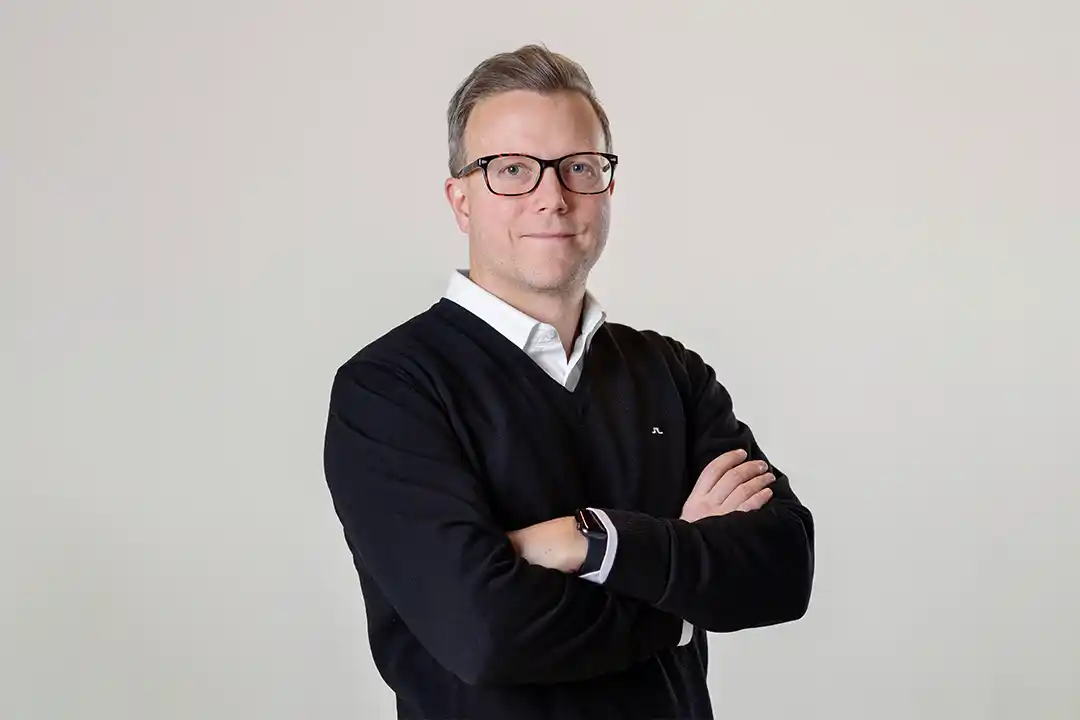
Andrew Kvålseth, CIO and EVP Growth and Investments in Schibsted.

Andrew Kvålseth, CIO and EVP Growth and Investments in Schibsted.
Looking at Schibsted’s marketplaces, they came from a horizontal classified business like you had in the printed paper, and then moved online becoming a success with brands like FINN in Norway, Blocket in Sweden and Lebocoin in France.
Now they are entering a transformational journey, moving into vertical business models, to make consumer experience better and more relevant.
“A good example is FINN, where if you buy your car in Norway, or sell your car like I recently did, you can do the entire journey through the platform. From transferring the ownership of the vehicle, to getting the right insurance, to ensuring your payments. And that’s what’s disrupting our marketplace model to a transactional end-to-end highly focused marketplace model.”
Supporting transformation
Looking at the larger acquisitions Schibsted made in the past year or two, a lot of them are focused on marketplace models that support this transformation. Autovex was acquired in Finland, a vertical specialist for car sales. Nettbil, a digital used car marketplace is another example, as is Gire Mobility, a B2B marketplace for flexible on-demand car transportation.
“There are more in the pipeline that we look at in this space,” Andrew reveals.
So, Schibsted is looking at both disruptive news media options and investing across the marketplace space.
“We still have a value-driven and long-term approach to our investments, as we had even during the more tiger-focused years. But we also need to stay curious, constantly try to learn and evolve, yet staying true to who we are and our mission as a company, empowering people in their daily lives.”
So, if we’ve left the tiger far behind – what animal would best describe that kind of investor?
“I would say maybe it’s the year of the dolphin, always stay curious and learning.”
[Sassy_Social_Share]

Nathalie Kåvin
Head of Corporate Brand, Schibsted
Years in Schibsted: 5
My favourite song the last decade: Stark & Sårbar – Moonica Mac
10 years in pictures
10 years in pictures
Which are the most memorable and best pictures from the last decade? As Future Report celebrates its tenth anniversary we have looked back and gathered pictures from Schibsted’s newspapers to also celebrate the art of photography.
By Espen Rasmussen | Read 'A new era for photo journalism'
2022: In the trenches, five minutes from the village of Novoluhanske. Five days after this picture was taken, Russia went to war. Photo: Paal Audestad, Aftenposten.

10 years in pictures
Which are the most memorable and best pictures from the last decade? As Future Report celebrates its tenth anniversary we have looked back and gathered pictures from Schibsted’s newspapers to also celebrate the art of photography.
By Espen Rasmussen | Read 'A new era for photo journalism'
2023: Drag queen duo Lillan and Tjorven perform theatre for children at Dramaten in Stockholm, days before being harassed by right-wing extremists.
Photo: Emma-Sofia Olsson, Svenska Dagbladet
2023: Drag queen duo Lillan and Tjorven perform theatre for children at Dramaten in Stockholm, days before being harassed by right-wing extremists. Photo: Emma-Sofia Olsson, Svenska Dagbladet
2021: Refugees attempting to cross the Mediterranean in inflatable dinghies.
Photo: Photo: Espen Rasmussen, VG
2021: Refugees attempting to cross the Mediterranean in inflatable dinghies. Photo: Espen Rasmussen, VG
2020: Mask marks that hardly have time to disappear, before they are back again. A telling image of the lasting impact on healthcare workers during the pandemic.
Photography by Andreas Bardell, Aftonbladet
2020: Mask marks that hardly have time to disappear, before they are back again. A telling image of the lasting impact on healthcare workers during the pandemic. Photo by Andreas Bardell, Aftonbladet
2019: After Helene Gallis was diagnosed with breast cancer, she invited friends to feel her breast and learn what a tumour can feel like.
Photo: Monica Strømdahl, Aftenposten
2019: After Helene Gallis was diagnosed with breast cancer, she invited friends to feel her breast and learn what a tumour can feel like. Photo: Monica Strømdahl, Aftenposten
2018: More than 50 forest fires ravaged Telemark in Norway, officials called it “the worst forest fire in 27 years.” Pictured is the civil defence team at Elgsjø on Notodden in Telemark.
Photo: Helge Mikalsen, VG
2018: More than 50 forest fires ravaged Telemark in Norway, officials called it “the worst forest fire in 27 years.” Pictured is the civil defence team at Elgsjø on Notodden in Telemark. Photo: Helge Mikalsen, VG
2017: Tomas Oneborg was supposed to photograph sweets for Easter at Hötorget in Stockholm, when the terrorist act on Drottninggatan threw him into the chaos.
Photo: Tomas Oneborg, Svenska Dagbladet
2017: Tomas Oneborg was supposed to photograph sweets for Easter at Hötorget in Stockholm, when the terrorist act on Drottninggatan threw him into the chaos. Photo: Tomas Oneborg, Svenska Dagbladet
2016: The war in Syria is in its tenth year. Maha is only five. She and her family fled their hometown of Hawiga outside Mosul to escape ISIS. “I don’t dream anymore, and I’m not scared of anything,” she says.
Photo by Magnus Wennman, Aftonbladet
2016: The war in Syria is in its tenth year. Maha is only five. She and her family fled their hometown of Hawiga outside Mosul to escape ISIS. “I don’t dream anymore, and I’m not scared of anything,” she says. Photo: Magnus Wennman, Aftonbladet
2015. 26-year-old Ibrahim Abdulla under a trailer in the port city of Patras, Greece. He can’t say for sure how many times he has tried to get the ferry to Italy.
Photo: Paul S. Amundsen, Bergens Tidende
2015. 26-year-old Ibrahim Abdulla under a trailer in the port city of Patras, Greece. He can’t say for sure how many times he has tried to get the ferry to Italy. Photo: Paul S. Amundsen, Bergens Tidende
2014: The children of Gaza were hit hardest by the war. A fourth of the Palestinian victims were minors. As we produce the report in the autumn of 2023, the Middle East conflict has once again exploded.
Photo: Yvonne Åsell, Svenska Dagbladet.
2014: The children of Gaza were hit hardest by the war. A fourth of the Palestinian victims were minors. As we produce the report in the autumn of 2023, the Middle East conflict has once again exploded. Photo: Yvonne Åsell, Svenska Dagbladet.
Trust and credibility will fuel news media
Trust and credibility will fuel news media
Journalism is facing fundamental challenges as online newspapers are no longer cutting-edge. A group in Schibsted has worked to set the direction for newsrooms in Sweden and Norway in the AI era.
By Gard Steiro

Trust and credibility will fuel news media
Journalism is facing fundamental challenges as online newspapers are no longer cutting-edge. A group in Schibsted has worked to set the direction for newsrooms in Sweden and Norway in the AI era.
By Gard Steiro
The editor stood wide-legged in front of the editorial team. On the wall behind him shone an image of a long suspension bridge over a turbulent sea. On one side lay a grey and abandoned village, on the other, an idyllic island with coconut palms, white sand and an aura of nirvana.
“Guys,” said the editor. “Now we just have to cross this bridge. Over to the digital side. It’s safe and comfortable there.”
This is a quite common metaphor in the media sector: the digital transformation is a journey from A to B. From a print to an online newspaper. From radio to podcast. From linear television to streaming.
This is wrong.

We need to drop the metaphor that digitalisation is a bridge to cross, in the sea. It has no end point.

We need to drop the metaphor that digitalisation is a bridge to cross, in the sea. It has no end point.
Let’s once and for all bury the bridge metaphor. Or – more precisely – drop it in the ocean and let it sleep with the fishes. Because the digital transformation is not a journey. It has no endpoint. We cannot look forward to calm days on a paradisiacal island. No, unfortunately, we are doomed to eternal sailing in turbulent waters.
“We are no longer talking about digital transformation, but the transformation of digital,” said Nic Newman, Senior Research Associate at the Reuters Institute for the Study of Journalism.
Several journalists have later made the quote their own. It’s not surprising. Newman is right. Everything suggests that editor-driven media, even in the most digitalised markets, now face fundamental changes. Online newspapers as we know them are no longer cutting-edge. They may suffer the same fate as the print editions. It is adapt or die. Again.
This is something we have tried to address at Schibsted News Media. In the spring of 2023, a group of employees worked to set a direction for newsrooms in Norway and Sweden. The goal was not to micromanage editors or editorial teams. They are autonomous units and know their users best. Media houses cannot and should not be subjected to micromanagement.
Moreover, for a large media conglomerate such as Schibsted, it is beneficial and essential that media houses do not make exactly the same decisions in all situations. Different approaches ensure broad innovation, ample room for experimentation, and cross-brand learning.
But some trends are so fundamental that no one can afford to overlook them. The changes are so significant that the media must collaborate to adapt to a completely new reality. Some of these potential epochal shifts for journalism were addressed by the project Next Generation Newsrooms. The work resulted in a series of proposals for initiatives at Schibsted News Media. Here are three of the most crucial:
Invest in our brands
Invest in our brands with trust and authenticity as our main differentiator. In general, Schibsted’s brands have high trust, and we set strict requirements to adhere to our editorial guidelines. But all media are being challenged by generative AI on parameters such as speed, cost, and product experiences. It will become increasingly challenging both for reporters and the audience to navigate sources and facts amidst the explosion of content production.
Therefore, there is reason to prepare ourselves for trust and authenticity to be our most important value proposition. Authenticity is our strongest card when much of today’s human-created content can be replaced by generative AI. The media needs to strengthen and nurture trust and authenticity, and equally important: communicate clearly how we work and how we adhere to our ethical standards. We cannot take for granted that the audience understands what lies behind genuine, truth-seeking journalism.
Leverage AI
Leverage AI for better products and efficient newsrooms. Schibsted News Media has been experimenting with AI and robot journalism for a long time and has a strong foundation to build on. However, the use and development of AI tools have often been limited to specific groups and have not transpired into widespread knowledge. This cannot continue. Whilst generative AI poses a threat to us, it will be a crucial enabler to deliver on customer expectations regarding our product and content. To succeed, time is of the essence, both to reap short-term benefits and even more importantly to experiment and get familiar with AI in the newsrooms, to keep up and adapt.
After the project group delivered its recommendations, all media houses in Schibsted appointed AI-responsible personnel. Several teams are collaborating across the board and sharing experiences. We have hired a coordinator with substantial technological and journalistic experience to lead the work. One of the goals is to identify potential new needs and steps in the editorial workflow and recommend the next actions for tooling development. The significant change, however, is not about building tools but creating a culture for experimenting with generative AI throughout the organisation. Even though this technological paradigm shift can be a threat and must be met with healthy criticism, we must also embrace all the opportunities we now have. They can represent a new spring for journalism.
Challenge ourselves
Challenge ourselves from within and outside. If we are to be completely honest, not much has changed since the first online newspapers became accessible to everyone in the early 2000s. We still present our content in traditional formats. The storytelling techniques are strikingly similar to those we swore by when print newspapers were at their peak. It’s a paradox. Our users have long since adapted to new content formats. And yes, they actually prefer them to news media.
Surveys show that the next generation of news readers spend far more time on TikTok than on all traditional media. But that’s not all. They also use social media to keep up with the news picture, even during major news events. We cannot overlook this.
Our challenge is that our core audience, the traditional newspaper readers, are highly satisfied with our products. If we change too much and too quickly, they protest. It’s bad for business. The consequence is that we spend a lot of time on incremental innovation, but we probably do not allocate enough time and resources to radical changes and experimentation. This causes the gap between us and the next generation to widen. And it could become so large that it’s impossible to build a bridge (pun intended) over the chasm.
To avoid this future, it was a clear recommendation from the project that Schibsted allocate more resources to creating news products specifically targeted at young people and other groups who do not find us relevant today. This can naturally happen under an established brand, but we believe that we should also test out entirely new services, not necessarily to replace today’s websites, but to enable experimentation with very radical solutions.
The project does not point to a single redemptive solution for the newsrooms of the future. We cannot draw a detailed map to a safe haven for journalism. Our suggestion is rather to launch a whole series of large and small speed boats that can provide us with a higher development pace, better dialogue with the audience, and a greater opportunity to adapt to a technological shift that we haven’t seen the likes of since the internet emerged. We are not sure where it will lead us, but we are confident that our fuel will be trust and journalistic credibility.
[Sassy_Social_Share]

Gard Steiro
Publisher, VG
Years in Schibsted: 23
My favourite song the last decade: I Need Never Get Oold – Nathaniel Rateliff & The Night Sweats
Meet Our People 2024: Business
Meet some of our people
New offers of news bundles are a first move to create an ecosystem within Schibsted. AI brought a 500-year-old king to life. Tibber will help you get in control of your energy consumption. Meet three people from different Schibsted business areas.

Meet some of our people
New offers of news bundles are a first move to create an ecosystem within Schibsted. AI brought a 500-year-old king to life. Tibber will help you get in control of your energy consumption. Meet three people from different Schibsted business areas.
Schibsted is closer to an ecosystem
Schibsted has been working towards an ecosystem across our brands for many years. Now we’re getting one step closer with the Alpha project.
“Schibsted reaches 80% of all Swedes and Norwegians on a weekly basis through our different brands. So, we have a unique opportunity to give these users new offers and great experiences,” says Karl Hahtovirta, Director of Subscriptions in Sweden.
Karl, who has worked in all of Schibsted’s three business divisions, really sees how broadly Schibsted’s various products touch people in their daily lives.
Since we can share data across different Schibsted products, we have a much deeper understanding than before about the people who use our products and their needs. This data could help improve the products we have – Aftonbladet, for instance, could learn from the needs of Blocket users, Karl explains.
“We could also offer bundles with Schibsted brands or in co-operation with partners. And we could identify clusters of new products needed by these users and create them.”
As a start, Schibsted is already offering bundles of our different news brands in Sweden and Norway. Karl is also sure that the ongoing AI wave will open up for exciting opportunities, in which news brands can expand the content they serve and also offer the right format to the right user.
“In this AI-era, trust will be a great asset, and here Schibsted is well positioned with our loved brands.”
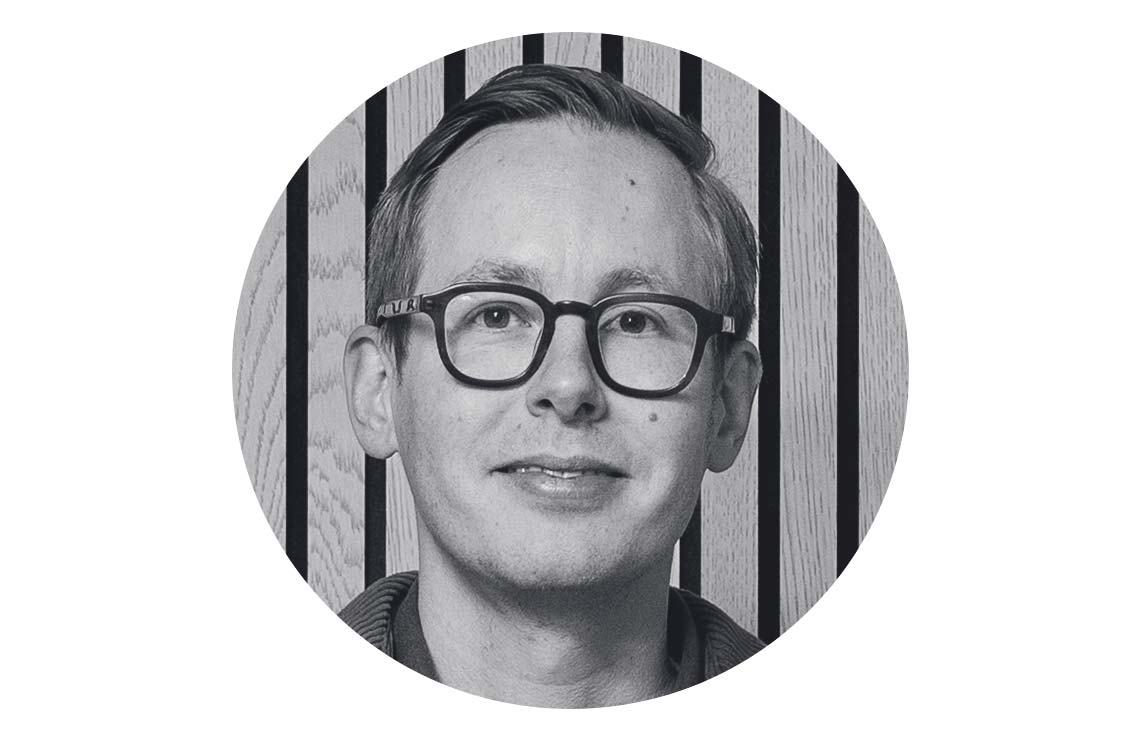
Karl Hahtovirta
Vice President Subscription Sweden, Schibsted
Years in Schibsted: 9
My favourite song the last decade: Get Lucky – Daft Punk
Chatting with a 500-year-old Swedish king
How do you bring a 500-year-old king to life? With the help of AI, of course.
“We created a chat where our readers could talk to Gustav Vasa. He got 2,000 questions and 60,000 people followed the live chat on Aftonbladet.”
Moa Gårdh is Director of Product at Aftonbladet. She is responsible for developing Aftonbladet as a product, making sure it lives up to users’ expectations – and at the same time ensuring it stays relevant and maintains its important role in society as a media company.
“The Gustav Vasa chat was an exciting way to develop editorial content and a great example of how we can work with AI. Not least it was a fun way to teach young people about history.”
Now, you might think that ChatGPT made it easy to create the chatbot. But it turned out there was a significant knowledge gap when it came to the historic Swedish king. So, the team behind it created a database with information about him, and they also trained the model to answer questions in a way similar to how Gustav Vasa would talk.
“It’s the social platforms that drive the development for how we consume content,” Moa explains, adding that as a media house, Aftonbladet needs to be open to new consumer habits and prepared to think outside the box.
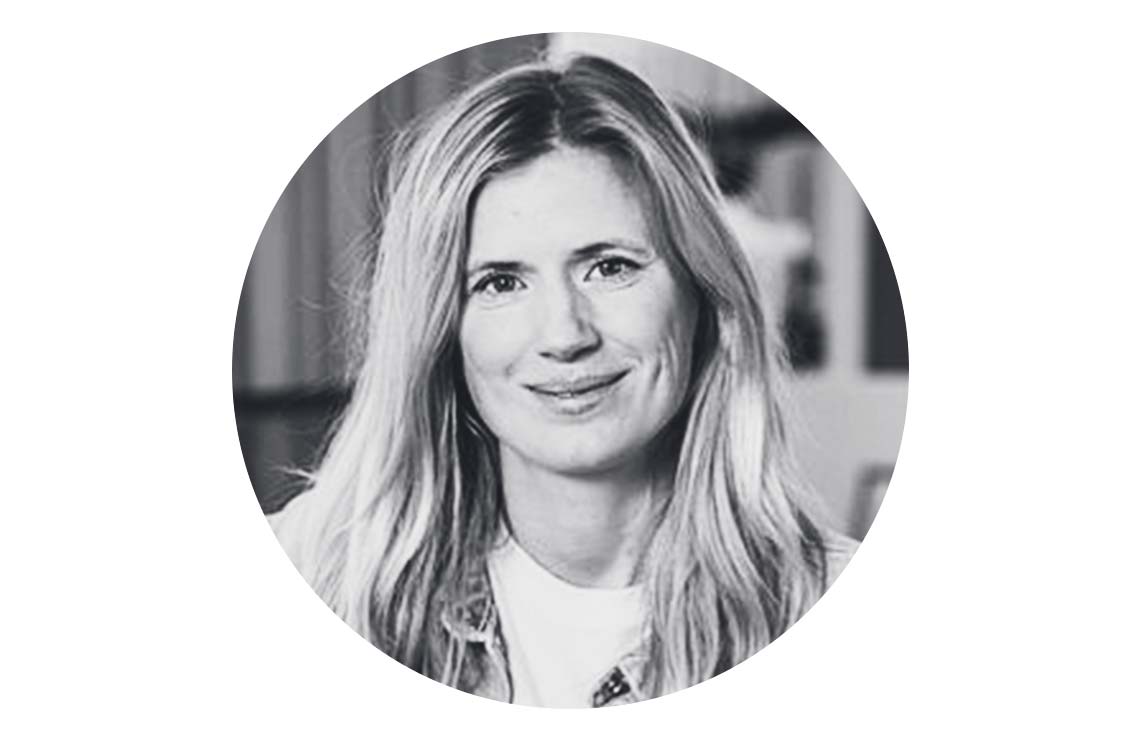
Moa Gårdh
Product och UX director, Aftonbladet
Years in Schibsted: 6
My favourite song the last decade: Ålen – Amason
Tibber is pushing an energy revolution
Their mission is to make green electricity more smart and cheaper for all households. Now Tibber has started to sell batteries to help consumers optimise their consumption, even more.
“We believe that technology will accentuate the green shift and every single customer experience. We are in the middle of a revolution,” says Edgeir Aksnes, CEO of Tibber.
The company delivers electricity to households in the Nordics, The Netherlands and Germany. But their idea is to help customer lower their energy cost with the help of digital services and devices. Like batteries for households with solar cells.
“We have created the world’s smartest battery, together with our partner Polarium. It adapts to electricity price, how much the sun is shining and to your consumption. And through our grid reward, you can get paid for supporting the power grid.”
Edgeir believes that helping people get control of their power consumption is crucial.
“When we started we had an idea that we would create the Internet Of Electrical Things. Today we see that that’s what we’ve done.”

Edgeir Aksnes
CEO and co-founder Tibber
Years in Schibsted: 2
My favourite song the last decade: Faded – Alan Walker
[Sassy_Social_Share]
Meet Our People 2024: Technology
Meet our people
Hanna Lindqvist is leading a project to create a new common platform for Schibsted’s marketplaces. Eivind Hjertholm Fiskerud is coordinating AI initiatives within news media and Deng Wuor Joak is detecting vulnerabilitis. Meet three Schibsted people working with tech.
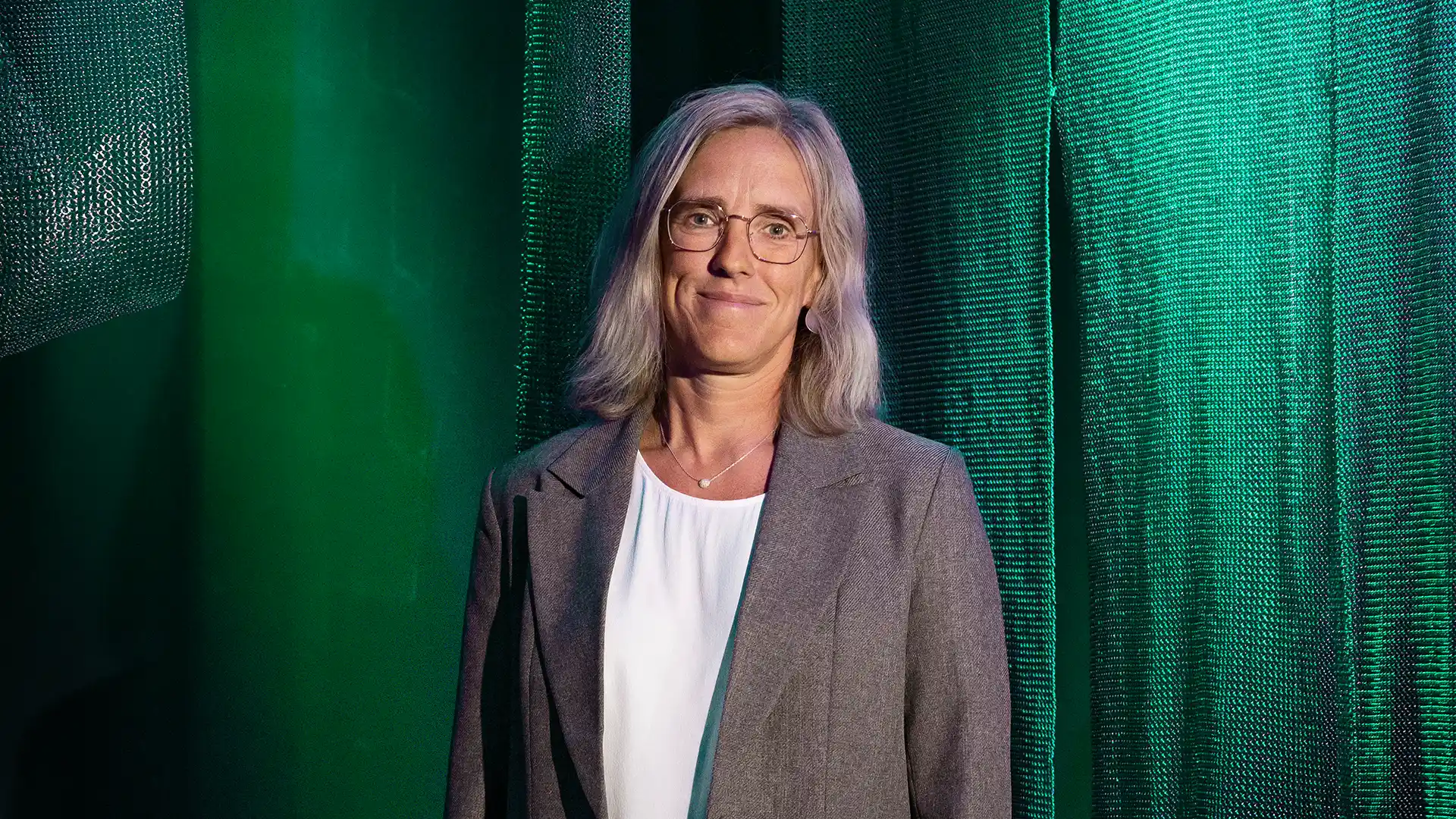
Meet our people
Hanna Lindqvist is leading a project to create a new common platform for Schibsted’s marketplaces. Eivind Hjertholm Fiskerud is coordinating AI initiatives within news media and Deng Wuor Joak is detecting vulnerabilitis. Meet three Schibsted people working with tech.
Giving users the best experience
After leading some large transformation projects at Svenska Spel and PayPal, Hanna Lindqvist was sure of one thing – never again. Nevertheless, she’s once again in charge of just such a project in Schibsted, creating a common platform for all Nordic marketplaces.
But Hanna seems calm and confident. The change is motivated by a clear goal: to give users of Schibsted marketplaces the best possible experience.
“When I came to Blocket two years ago, we worked as if conditions were the same for selling different things on the same platform, but different in different countries. Now we know that the user needs are similar when selling a car in all countries – but different from selling a t-shirt.”
That’s why Finn in Norway, Blocket in Sweden, Tori and Oikotie in Finland, and DBA and Bilbasen in Denmark are now cooperating to develop the best service in four categories. They will do so from the same new platform, a platform developed from one of Schibsted’s four exciting marketplace platforms, but good stuff from the others will be integrated.
“We talk about closing gaps,” Hanna explains. “This means testing and finding out what works and fixing what doesn’t.”
Making a shift like this is very business critical – and complicated. You can’t fail, and as you make the transition, business must run as usual.
The strongest upside for Hanna is working with all the people in different countries, and that confidence of hers relies on one simple fact.
“The transformation is made by our own people, people who know the platforms and the business.”

Hanna Lindqvist
SVP Technology, Schibsted and SVP Aurora Foundations
Years in Schibsted: 2
My favourite song the last decade: Wake Me Up – Avicii
He hacks to keep companies secure
He started his Schibsted journey as an engineer at Mitt Anbud four years ago. After coming second in a Schibsted hacking competition, a part of Schibsted’s security program, Deng Wuor Joak transitioned into the field of cyber security. He has since built a security program for both Mitt Anbud and Distribution Innovation to make sure that their systems are safe.
Distribution Innovation has developed new technology for logistics and more than 2.2 million deliveries each night are enabled by their services in Sweden, Norway and Finland.
“If we get hacked, most of the newspapers and parcels that are supposed to land on the doorsteps in a large part of the Nordics wouldn’t get there,” Deng says.
When he started at DI, the company lacked a security program, so he built one from scratch. The company’s security has gone through a large transition, since the development of this security strategy.
And Deng knows what he’s fighting for. After the hacking competition, his boss at Mitt Anbud asked him to ethically hack their site. As a result of the hacking, Deng found a severe vulnerability in their systems that he presented to other engineers. This led to a job offer from Distribution Innovation.
“Hacking got me into this field and I still find it challenging and exciting to find potential vulnerabilities.”

Deng Wuor Joak
Head of Cyber Security, Distribution Innovation, Schibsted
Years in Schibsted: 4
My favourite song the last decade: Mamma Sa – Jonas Benyoub
Using AI to strengthen news
Eivind Hjertholm Fiskerud has a long and storied history in Schibsted, having worked in several positions within Schibsted and Bergens Tidende. Now, he serves as Project Lead for Nextgen Newsrooms in Schibsted News Media, taking a central role in our work with AI.
“I’ve long been very interested in how we can use data to strengthen our news media,” Eivind says. When it comes to using AI in News Media, Eivind says it comes down to strengthening the journalists in their profession. Enhancing investigative journalism, using AI for creative storytelling, and making every day easier for our journalists by using AI for time-consuming tasks, letting them focus on the journalistic core.
News Media’s work in AI begins with a clear stance on how we use AI, grounded in our longstanding tradition of journalistic ethics.
“It’s important for Schibsted to be in the forefront in this area, to take responsibility and make sure AI is used in a responsible and trustworthy manner,” Eivind says.

Eivind Hjertholm Fiskerud
Project Lead AI, Nextgen Newsrooms
Years in Schibsted: 16
My favourite song the last decade: To Mminutter – Lars Vaular & Röyksopp
[Sassy_Social_Share]
Aftonbladet is ready for the AI revolution
Aftonbladet is ready for the AI revolution
New technology is just that. Technology. It’s when it’s in the hands of humans that it becomes transformative. People at Aftonbladet made it happen 30 years ago. And people will make it happen now, in the age of AI.
By Lena K Samuelsson

Aftonbladet is ready for the AI revolution
New technology is just that. Technology. It’s when it’s in the hands of humans that it becomes transformative. People at Aftonbladet made it happen 30 years ago. And people will make it happen now, in the age of AI.
By Lena K Samuelsson
Aftonbladet, the largest news destination in the Nordics, engages four million Swedes every day. They come to find out what happened, to understand why and to spend time with our content on news, sports, entertainment, food and lifestyle. They read, watch, listen and interact with us in a digital universe that has grown, flourished and developed over the years. A universe that also expands beyond Aftonbladet when younger audiences engage with our brand and news reporting on social media and through Google.
Embracing new technologies and channels in the service of journalism is what has moved Aftonbladet and Schibsted forward for decades, to the world-leading position in digital media we hold today. It has been quite a journey. Now, generative AI has taken centre stage, with full force. It will change us fundamentally. It is a new era. And it feels like 1994 all over again.
Phones were for talking
1994. The few who even had a mobile phone back then sported an Ericsson, Nokia or Motorola with an antenna. And phones were for talking. Yeltsin was the president of Russia, Clinton was still in his early days as president of the US. That autumn, the passenger ferry Estonia would sink on a stormy night in the Baltic Sea. Pulp Fiction and The Lion King were new movies. Jennifer Aniston starred as Rachel in the first episode of Friends, and we watched OJ Simpson flee from police on live TV.
I was on a trip to the States in the spring of 1994 when Aftonbladet “discovered” the internet. We were on a study tour to New York and then down to Atlanta. And that’s where it happened. But the truth is, on that particular day, we split up. My colleague and I visited the hottest new thing: CNN. The others, including Kalle Jungkvist, later the legendary first editor-in-chief of aftonbladet.se, visited the Poynter Institute and Atlanta Chronicle and Journal. And that’s where Aftonbladet discovered the internet.

Aftonbladet’s AI hub.

Aftonbladet’s AI hub.
Right from the start, it was clear that there were two exciting paths to take: News – like us, and classifieds – the marketplaces for buying and selling.
That same autumn, Aftonbladet went online, one of the first media houses in the world to do so. It was an act of curiosity, vision and maybe a little bit of madness.
What started out as a small group of open-minded people with different skills and experiences working together, experimenting and testing, would one day grow into a full organisation, forming the Aftonbladet Universe we know today. It was also the start of an ecosystem of media, marketplaces and other digital consumer services under the Schibsted brand. But that’s a story for another day.
Connected around the clock
No one could fully understand at the time how the internet would reshape the entire media business and our daily lives. No one knew that we would all carry incredibly powerful computers in our hands – and on our wrists – and that we would be connected around the clock. No one had heard of screen time, SEO or CTR. We couldn’t begin to comprehend the magnitude of the change.
But we knew it was something completely new. It was computers and code. But Aftonbladet turned the technology into a tool, helping us to create entirely new experiences around our journalism, multiply the number of readers and finally crack the code for business and payment. And in doing so, we managed to secure a unique digital position in the everyday lives of the Swedish people.
Aftonbladet’s breaking news desk.
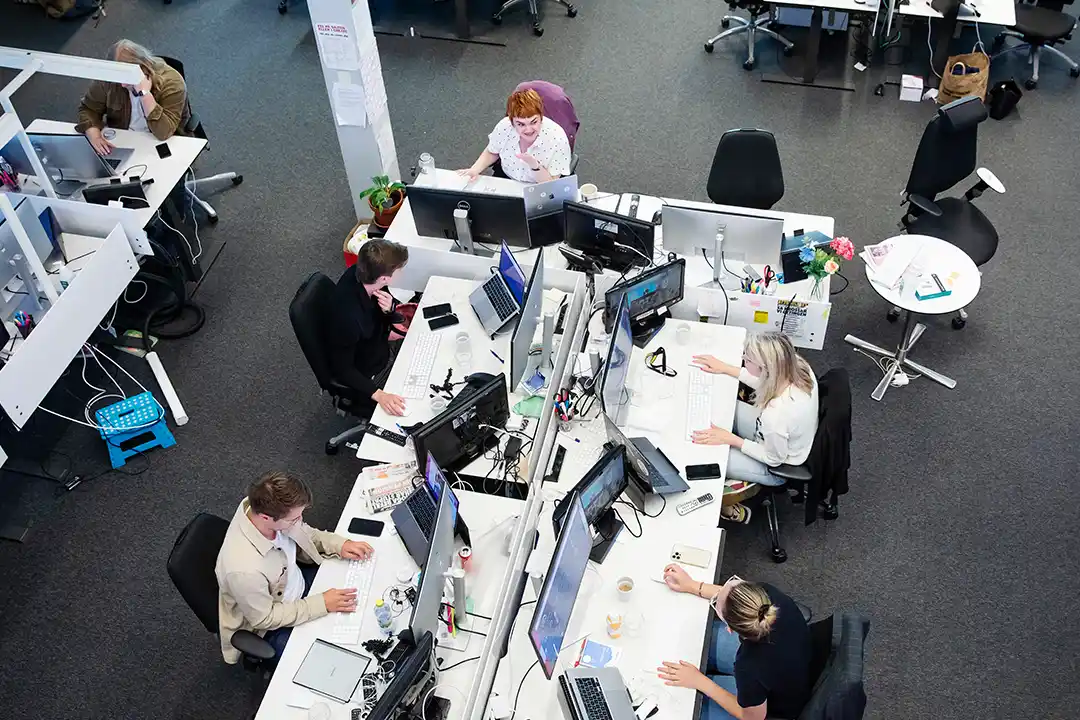

Aftonbladet’s breaking news desk.
2008. The web had challenged the business model of the print newspaper – a packaged product, sold at a specific time, to people who went out to the store to buy it. Now everyone could access Aftonbladet from home or work via their PC, around the clock.
Journalism had become accessible – and largely free. But when Steve Jobs stood on stage in a black polo in the summer of 2007 and introduced the iPhone, the printed evening paper was fundamentally challenged. Suddenly, readers were no longer tied to a computer; they could have Aftonbladet with them in their pocket or bag, anywhere, anytime.
Suddenly, readers were no longer tied to a computer; they could have Aftonbladet with them in their pocket or bag, anywhere, anytime.
And the rest is, as they say, history.
Aftonbladet realised faster than most that this was a groundbreaking shift. When the iPhone was launched in Sweden in 2008, a small group of people with experience, passion and knowledge from different parts of Aftonbladet – editorial, IT and business – took up the fight for the small screen, facing off with an already strong web organisation and a still very powerful print newspaper. Today, most people read us on their mobile phones, and still, we are stronger than others because we were quick to embrace the new technology and use it in the service of journalism. What was once a small team that challenged from within is now core business.
Today. With AI available to everyone, a new era begins. AI is clearly not a new channel, like the web or the mobile. It’s not a new product either. But it’s a technological shift that will change us fundamentally. With generative AI comes many challenges, but also immense opportunities for those who dare and who manage to go first.
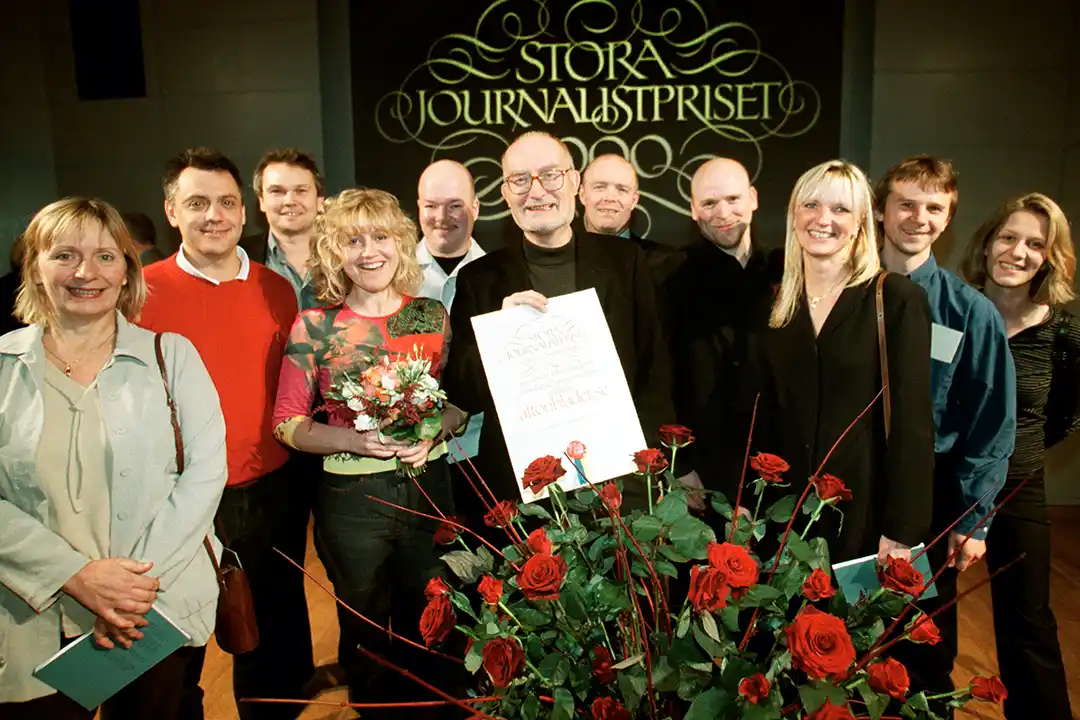
Aftonbladet celebrates winning Stora journalistpriset 2000 in the category New Media.

Aftonbladet celebrates winning Stora journalistpriset 2000 in the category New Media.
In many ways, we have moved past digitalisation; we are almost through it. Now it’s about transforming our digital self. Ensuring that Aftonbladet stands strong when we take the final steps from a newspaper online to a true online company with its heart and soul in journalism. A true online news site will be something else. Text, sound and video will merge into new user experiences, consumers will choose how they want to interact with us – rather than just be fed with a feed. Journalism will move beyond the traditional news destination and build more on relation to a brand and profiles. Content will to a much higher degree be personalised. The composition of an article and the presentation will cut its final ties to the print newspaper. Short versions and summaries will become core content, not add-ons. And storytelling will find new paths.
And, at this very moment in our journey, AI steps in. We don’t know where this is going to take us. We can’t foresee how AI will transform society or us. But we know it is something new. And we are, as always, curious.
Generative AI will create entirely new conditions for our industry. The one who is quickest to understand and use the new technology will have a huge advantage. Media houses that dive into AI, that unsentimentally examine all their processes and become much better at taking care of both users and customers, will stand strong. Many others will not.
It’s about a culture that embraces data, personalisation and algorithms, making technology our strongest ally in the service of journalism.
A powerful tool
AI can become a powerful tool for free and independent journalism and for Aftonbladet, as a true digital company, to be more sustainable, more efficient and even smarter.
AI can also become a tool for disinformation and hate. We will investigate and report on this; we will use AI-empowered journalism as a counterforce. We will help our readers understand the societal shift we are now entering. And we must understand it ourselves. It might be frightening. But it’s also incredibly exciting.
So, here we go again! It’s time for Aftonbladet to turn things upside down. And today we do it together in Schibsted, a group that is world-leading in digitalising its media houses and already has many AI initiatives and specialised common teams.
To genuinely build an Aftonbladet that utilises the full power of generative AI, we have put together a small group of people who are passionate about new things. No one is an expert when it comes to what we don’t know. So, these individuals have different skills and experiences. They come from the newsroom, sports, print, product, pod, tech and UX. They will challenge us, experiment and test stuff, along with our users. And they will slowly change us from within. As always.
Because new technology in the hands of inspired people is transformative. That’s the Aftonbladet Way.
(And yes, this text was written with the assistance of my new friend Chat.)
[Sassy_Social_Share]

Lena K Samuelsson
Publisher Aftonbladet & founder of Schibsted Future Report
Years in Schibsted: 27
My favourite song the last decade: Shallow – Lady Gaga & Bradley Coop
When we unify our efforts, we can be in the forefront
“When we unify our efforts, we can be in the forefront”
Schibsted has a new SVP Engagement, Communication and Employer Branding. Jane Throndsen has her roots in News Media, coming from VG. Now, her primary focus is to create a common mindset about what Schibsted can achieve together – in a world that’s on fire.
By Ann Axelsson
Jane worked as an editor at the competitor newspaper Dagbladet in Oslo before being recruited by VG in 2012. During her time at VG, she served as both the Feature Editor and later as the Head of Paid Content, holding key positions within VG’s management team. After just two years at VG, she was named the Female Media Leader of the Year in Norway.
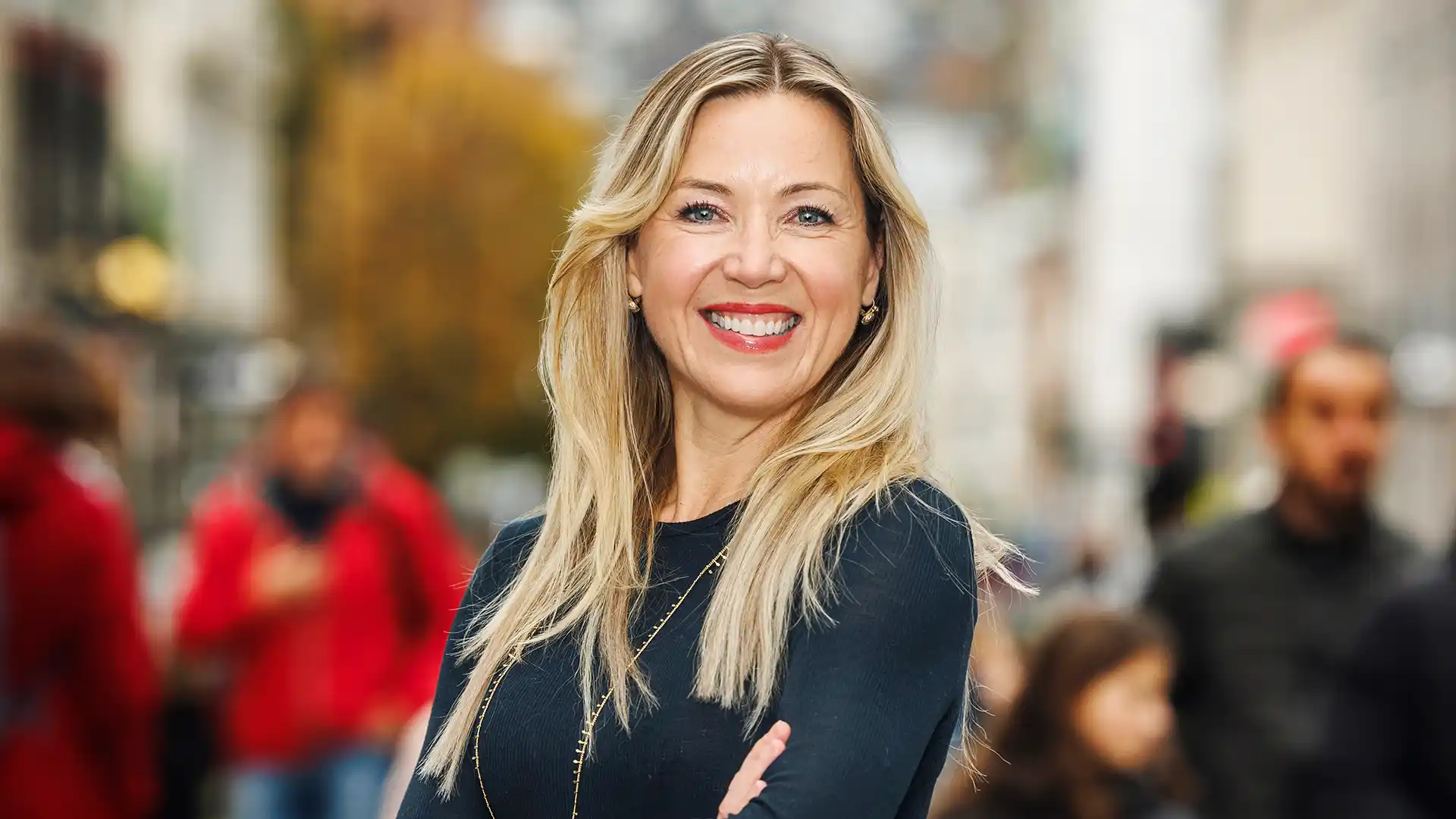
“When we unify our efforts, we can be in the forefront”
Schibsted has a new SVP Engagement, Communication and Employer Branding. Jane Throndsen has her roots in News Media, coming from VG. Now, her primary focus is to create a common mindset about what Schibsted can achieve together – in a world that’s on fire.
By Ann Axelsson
“Schibsted is a company with enormous power and so many competent people. At the same time, it’s a complex matrix organisation, with all its functions and brands,” says Jane.
Schibsted has some of the strongest brands in the Nordics. And it is not always obvious to employees in each of those brands why they are a part of Schibsted. Jane knows this well, having come from VG. She points out that each brand does an excellent job in engaging their employees – but that there is room for more of a Schibsted perspective. She wants to build this common pride, brick by brick.
Amidst this complexity, internal communication can be a strong tool to create knowledge and trust in a shared strategy, where a main message for Schibsted is that we are more than just the sum of our parts.
“I would like for our employees to feel that they are part of something bigger – and that bigger is supporting the job they’re doing.”
A tough future to navigate
And she is certain that Schibsted’s muscles are needed today. The world is literally on fire. As we speak, the conflict in the Middle East has just awoken. Jane points out the pressure that freedom of the press is under and how media is a cornerstone in a democratic world. But there is also fierce competition from tech companies and technology advancements that will have a great impact on all businesses. It’s a tough future to navigate – and a united Schibsted is a stronger force to take on this future and this level of competition versus each of its brands alone.
Jane mentions common AI initiatives as an example of how to use those Schibsted muscles across the company.
“There is so much innovative spirit in Schibsted. Different AI initiatives pop up all over, and new applications are shared across. When we unify our efforts, we can be in the forefront.”
Building internal engagement is also about offering common arenas where people can meet and discuss, like strategy meetings for leaders, tech gatherings, and the Power of Journalism initiative – a conference and awards ceremony where we celebrate the importance of quality journalism.
Global talent competition
Then there is the global competition for talent. To attract the right people Schibsted also needs to step up and show what makes us different from other workplaces – in an authentic and transparent way.
“We need to make the success stories from all our brands come alive. That’s how we can both attract talents and build pride in being part of the Schibsted family.”
Leaving VG for Schibsted was not an easy decision. And she says that she will miss journalism every day. But she also believes that bringing this perspective into a new role is helpful.
“I’ve seen things from a brand’s point of view. Bringing that experience and my competencies into Schibsted and being part of shaping and growing the company for the future is really exciting.”
[Sassy_Social_Share]

Ann Axelsson
Senior Product Manager, Strategic Communication, Schibsted
Years in Schibsted: 25
My favourite song the last decade: Paper Doll – John Mayer
Worklife trends 2024
Worklife trends 2024
The world of work is in a constant state of flux, with each passing year bringing about new trends and innovations that shape the way we work, interact and live. From the integration of Virtual reality to a shorter workweek and the continued impact of the pandemic, here are the work-life trends you need to know about.

Worklife trends 2024
The world of work is in a constant state of flux, with each passing year bringing about new trends and innovations that shape the way we work, interact and live. From the integration of Virtual reality to a shorter workweek and the continued impact of the pandemic, here are the work-life trends you need to know about.
Global and remote talent acquisition
Companies are increasingly open to hiring remote talent from anywhere in the world. This trend is leading to more diverse and geographically dispersed teams, enriching the talent pool and promoting innovation through diverse perspectives.
AI-powered productivity tools
Artificial intelligence and automation continue to be integrated in the workplace, assisting with tasks such as data analysis, customer support and scheduling. These AI-powered productivity tools enhance overall efficiency, allowing employees to focus on higher-value tasks that require creativity and critical thinking.
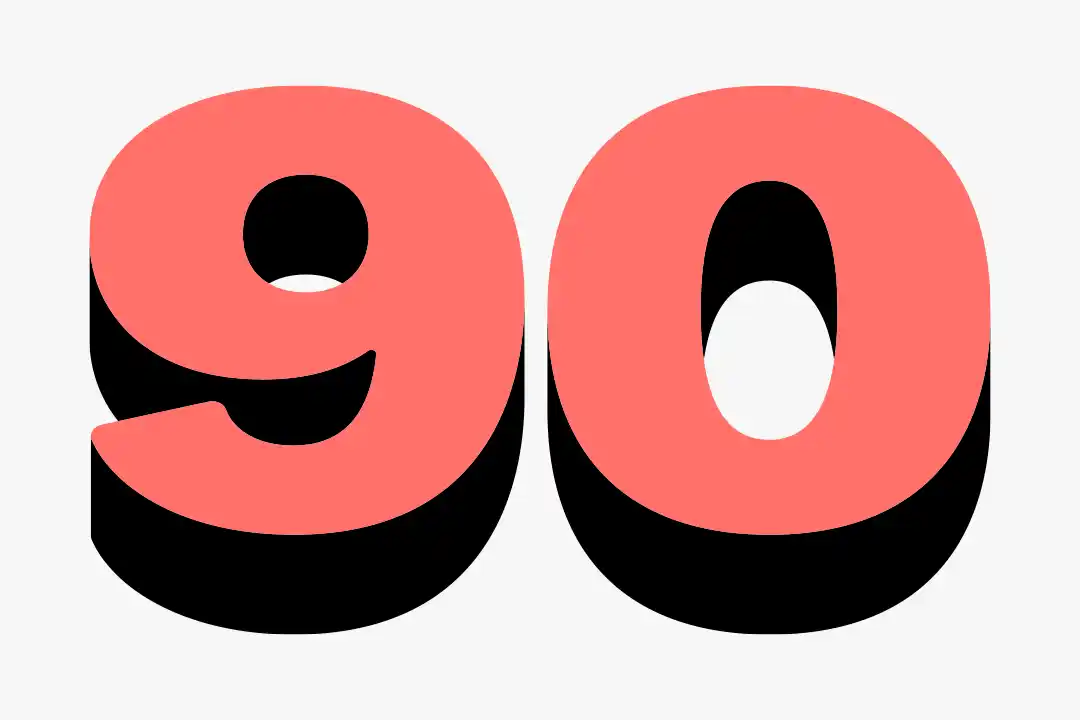
90% of people believe it matters how we feel at work.

90% of people believe it matters how we feel at work.
90% of people believe it matters how we feel at work, according to Indeed research. 49% feel their organisation is focused on measuring and improving well-being. Mental health support at work has taken on even greater significance, with companies offering a wider range of mental health resources and destigmatising discussions about mental well-being. As employees face ongoing challenges, fostering a supportive and understanding workplace is essential to maintaining productivity and employee morale.
Four days of work a week is achieved by eliminating non-productive activities.


Four days of work a week is achieved by eliminating non-productive activities.
A global shift to four days of work
The concept of a four-day workweek is gaining momentum worldwide. Trials have taken place in various countries, including the UK, Belgium, Sweden and Iceland. In 2023, this trend will extend to the US, Scotland, Ireland, Canada and New Zealand.
In the UK, a remarkable 86% of participating companies expressed interest in adopting a permanent four-day workweek policy. Employees are expected to maintain their workload while enjoying an extra day off.
This reduction in working hours is achieved by eliminating non-productive activities, agreed upon in consultation with employees and their supervisors. The four-day workweek promises improved work-life balance and increased employee satisfaction.
Hybrid work models: The new normal
The enduring effects of the pandemic have led to the widespread adoption of hybrid work models, in which employees split their time between remote and in-office work. However, this model presents challenges in scheduling and internal communication, necessitating advanced VR and digital tools to enhance corporate communication for remote employees.
Companies are investing in technologies to bridge the gap between remote and in-office workers, ensuring seamless collaboration and communication. This shift is likely to persist as organisations prioritise flexibility and adaptability in their workforce strategies.
58% of American workers had the opportunity to work from home in 2022.
48% of the workforce will continue to work remotely or in a hybrid fashion, says a survey from Omdia.
58% of Omdia’s survey respondents believe work-from-home has increased productivity.
0% of Tesla’s employees are allowed to work remotely.

New trends and innovations shape the way we work, interact and live.

New trends and innovations shape the way we work, interact and live.
“Quiet hire” and continuous learning
Lifelong learning has become a cornerstone of corporate culture as employees regularly upskill and reskill to stay competitive in a rapidly evolving job market. In 2023, forward-thinking organisations are embracing the concept of “quiet hiring” as a way to acquire new skills and capabilities without adding new full-time employees.
This involves encouraging internal talent mobility, offering specific upskilling opportunities, and leveraging alternate methods like alumni networks and gig workers to fulfil high-priority tasks when a new headcount isn’t feasible. By maximising existing talent and nurturing their growth, companies can remain agile in a dynamic job landscape.
982 billion USD (approximately) is the expected value of the AI recruitment market by 2029. 6.8% is the annual growth rate. As AI plays a more significant role in recruiting, ethical concerns are gaining prominence. Governments are scrutinising AI’s use in hiring, leading organisations to be more transparent about their AI practices, disclose audit data, and offer candidates the option to opt out of AI-led processes. This push for transparency ensures fairness and equity in the hiring process.
VR-developments signal a new era in remote work and collaboration.
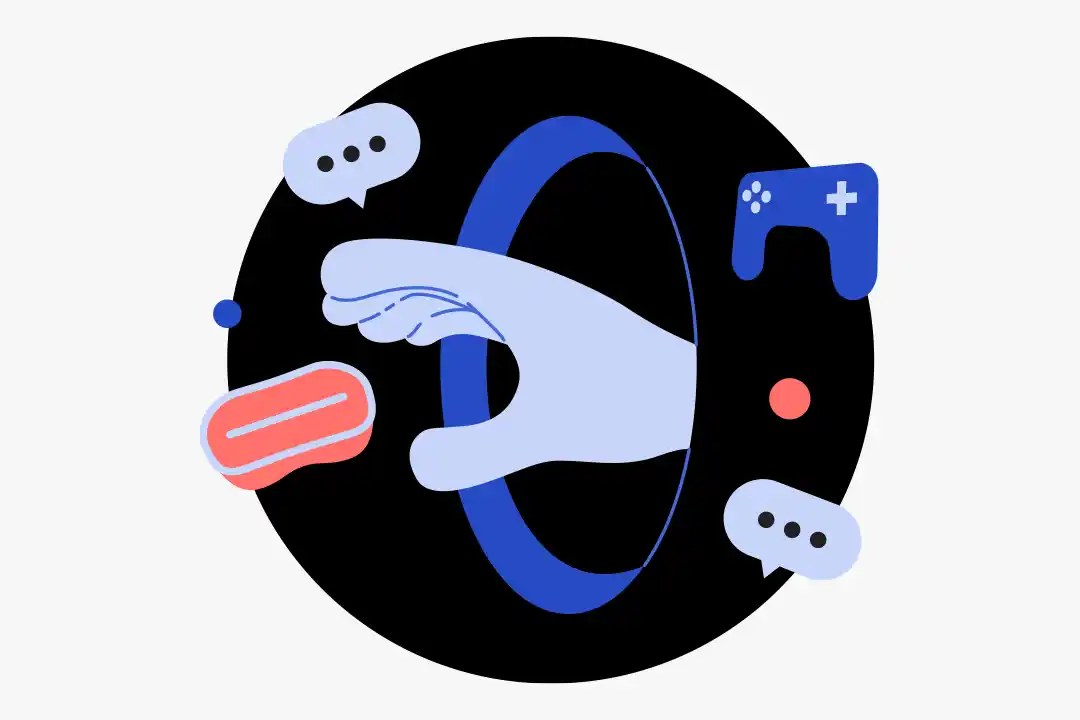

VR-developments signal a new era in remote work and collaboration.
VR for work: Connecting in the Metaverse
Virtual reality (VR) is taking the corporate world by storm. Unlike traditional video conferencing, VR allows employees to inhabit the same virtual space and manipulate reality data in real-time, creating an unparalleled level of global connectivity. This technology is set to reshape the future of our digital experiences.
In practice, VR is being used across various industries. NASA and armed forces are utilising VR for training, reducing risks and costs. Retail giant Walmart leverages virtual simulations to prepare employees for high-pressure events like Black Friday. Meta is actively promoting VR experiences aimed at enhancing workplace inclusion.
Meta has introduced Horizon Workrooms, a virtual working environment that facilitates collaboration. Nvidia’s Omniverse is being marketed as a metaverse platform, and Microsoft’s Mesh adds avatars and mixed reality capabilities to Microsoft Teams. These developments signal a new era in remote work and collaboration.
[Sassy_Social_Share]
A new era for photo journalism
A new era for photo journalism
Today’s photojournalists must be full-service suppliers in the digital visual field. It’s a change that creates much more breadth and depth. Photo editor Espen Rasmussen reflects on how the job has changed during the last decade.
By Espen Rasmussen | Watch t 10 years in pictures

A new era for photo journalism
Today’s photojournalists must be full-service suppliers in the digital visual field. It’s a change that creates much more breadth and depth. Photo editor Espen Rasmussen reflects on how the job has changed during the last decade.
By Espen Rasmussen | Watch 10 years in pictures
Two years ago, I stood on deck aboard the ship Geo Barents, operated by Doctors Without Borders, to document refugees attempting to cross the Mediterranean in inflatable dinghies. Thousands drowned, many were rescued and brought ashore in Italy, while others returned to the north coast of Africa.
I met 17-year-old Zalman, who on his tenth attempt at crossing was finally rescued.
At the age of six, he was orphaned and forced to live on the streets of the Somalian capital Mogadishu. He later fled to Libya, where he was captured by traffickers and tortured. Finally, he made it onboard the inflatable boat, ready to cross the Mediterranean.
A digital special in VG
The story of the rescue and of 17-year-old Zalman was published as a major digital special in VG. With videos, audio, photographs, graphics and text. It was presented in several chapters, adapted to the mobile phone.
In many ways, this story represents the evolution of photojournalism.
Today, stories are told using all the tools in the toolbox. In addition to photography, film is essential. Video adds something extra to the story when it’s presented digitally. It provides presence and emotion. Several of today’s photojournalists also supply text, and they are able to piece together the digital stories in the publishing tool of choice.
Photojournalists have gone from being classic photographers to now serving as suppliers across a much broader area.
Out in the field, it’s about being able to master photography, film, sound, drone use and interviews. And for breaking news, you should be able to broadcast live TV.
Back at the office, it’s about being able to master a number of tools for editing, have insight into how the content management system works and collaborate closely with developers and designers.
We need a plan
We’ve gone from working with individual images for print media to now relating to the fact that almost 90% of all journalism in VG is consumed on mobile phones. For photojournalism, this means that photographers must already have the story in mind before they leave the office, to a greater extent. We need to have a plan for how we want to tell it.
Today, photography is as much about journalistic content as it is about giving digital stories a visual boost and getting readers to scroll on.
The story of 17-year-old Zalman and the refugees attempting to cross the Mediterranean has been forever burned in my memory. And it also serves as an example of how today’s photojournalists must be full-service suppliers in the digital visual field. It is a change that creates much more breadth and depth, makes us much more versatile photographers and, not least, results in more impactful photo stories that touch our readers.
[Sassy_Social_Share]

Espen Rasmussen
Photo Editor, VG Stories
Years in Schibsted: 17
My favourite song the last decade: Golden Ticket – Highasakite
Co-creation sparks innovative solutions
Co-creation sparks innovative solutions
News as music, dynamically adjusted content to match your emotional state or combining mindfulness and news. IN/LAB is experimenting to find news experiences that can engage news outsiders.
By Molly Grönlund Müller, Belenn Rebecka Bekele
Rami Syrag, Safy Adem and Salem Mohammad Ali, is working on an idea in an IN/LAB ideation session.
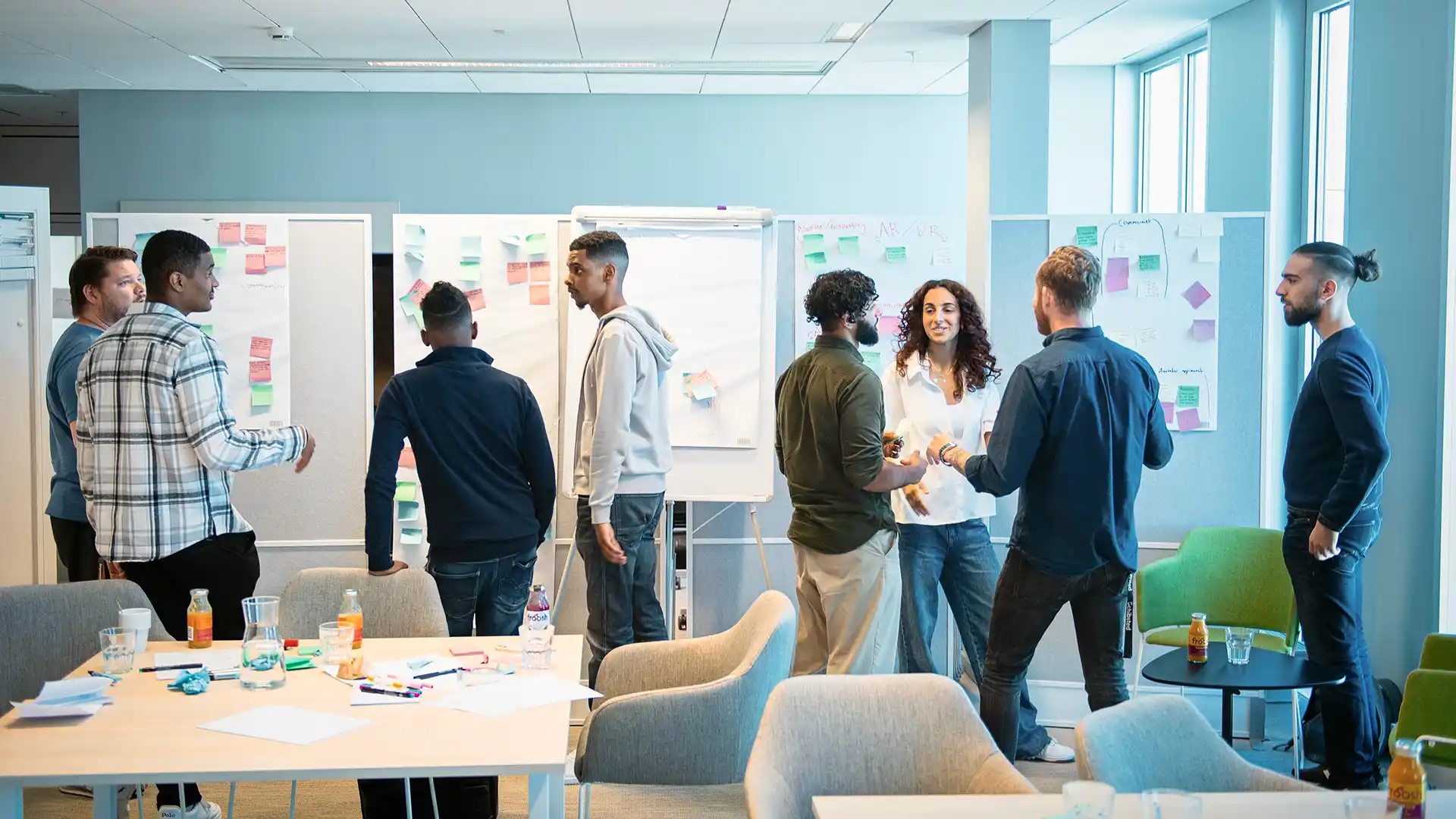
Co-creation sparks innovative solutions
News as music, dynamically adjusted content to match your emotional state or combining mindfulness and news. IN/LAB is experimenting to find news experiences that can engage news outsiders.
By Molly Grönlund Müller, Belenn Rebecka Bekele
IN/LAB’s mission is to prototype future news experiences for current news outsiders. We listen to their perspectives, seek to identify pain points and explore how these can be catered to in future news experiences.
At IN/LAB, a joint venture between Schibsted and the Tinius Trust, we believe that co-creation holds the key to unlocking new ideas and solutions. By bringing together people with different perspectives, experiences, and skills in collaborative creative processes, we can better imagine what the future of news could look like.
Include to innovate
To enable sustainable developments in the news industry, we believe more diverse voices need to be included in conversations about future products and formats. In this age of rapid transformation, our industry needs great ideas – and we need to – recognise that they may not always come from people heavily invested in traditional ways of doing things.
A 2023 study by IN/LAB and Järvaveckan Research showed that close to half of Swedes and Norwegians actively avoid the news, with frequent news avoidance being especially high in socio-economically vulnerable areas. We think it is of critical importance that we bring these voices in; we need to talk with, not about, them and their perceived issues with the news media.
When we share that our lab is called “IN/LAB,” many assume that the “IN” is for innovation. But really, it stands for inclusion – which in turn enables innovation.
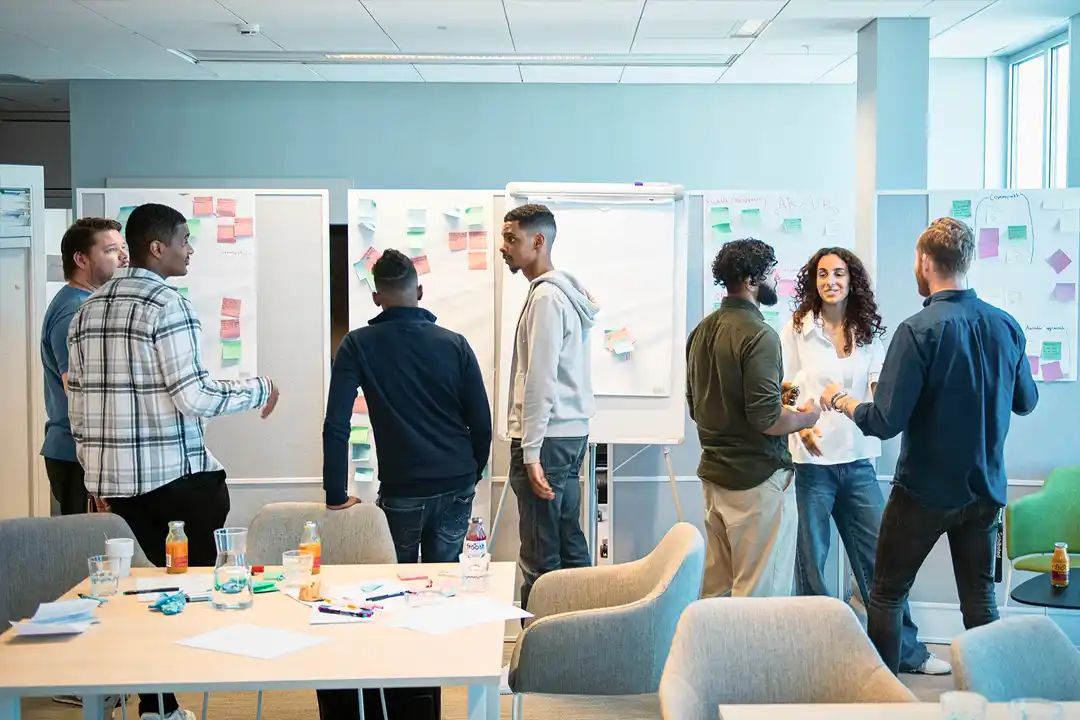
IN/LAB’s co-creation processes inspire thought-provoking discussions and raise important questions about the possible futures of news.

IN/LAB’s co-creation processes inspire thought-provoking discussions and raise important questions about the possible futures of news.
Co-creation with young users
Our efforts have involved diverse groups, including young teenagers from outer city Stockholm, young tech enthusiasts and graduates working to fight climate change. What all our great co-creators have in common is that they express various pain points in and from their news experiences. These pain points involve news that makes them feel too sad and frustrated or news that fails to highlight diverse perspectives. Other frustrations involve experiences with contemporary product formats that don’t fit with the needs and wants of the group.
During our first year of operations, we have sought to understand these themes by hosting brief ideation sessions, deep-dive workshops, and programs spanning multiple months. The work always starts with a problem or pain point identified, upon which we typically phrase a “How might we…” statement for the selected group of co-creators to transform into a possible future solution. Example statements that our work has explored include: “How might we enhance voices from outer city areas with digital tools?”, “How might we involve our friends in our news experience?” or “How might we consume climate news in a way that gives us hope for the future?”
Prototyping Possible Futures
Our co-creation processes have yielded prototypes of varying degrees of sophistication. Regardless of their format, they serve the common purpose of inspiring thought-provoking discussions and raising important questions about the possible futures of news. To truly innovate, we need to be open to exploring not only the most probable or desirable scenarios but a broader spectrum of futures as well. This is important because some of the challenges facing the news media today might need more than incremental improvements.
By prototyping possible futures, we make them more tangible. Examples of IN/LAB prototypes include:
News as music was a prototype news experience presenting news to the beat of AI-generated music – or as an AI-generated rap song. The experience was tested live on Aftonbladet.se for 1,000 selected young users and was positively received. The idea came from the News Changemaker Program, our ten-week youth co-creation program.
Senti Sense is a fictional news product that analyses the user’s reactions to news in real-time and dynamically adjusts news content (e.g., language, tonality and angles) to match the user’s emotional state and empower feelings of clarity and understanding when consuming news. The idea came from News2030, our five-day design sprint co-hosted with Schibsted News Destination Engineering.
Mindfulne(w)ss is a fictional app combining news and mindfulness to make you more conscious in your news consumption. The app contains a conscious check-in, slow scroll and no clickbait – all to promote inner calm. It guides you through the emotions you get when reading a news story and helps you reflect on the news content. The idea came from our co-creation workshop with Naturskyddsföreningen’s young ambassadors.
The power of co-creation
By fostering an environment of shared creativity, we can find new ways of reaching potential audiences and tackling critical problems in the news media industry. Our work underscores the power of co-creation in sparking innovative solutions to shape a sustainable path forward.
[Sassy_Social_Share]

Molly Grönlund Müller
Community Researcher, IN/LAB
Years in Schibsted: 1
My favourite song the last decade: Step Out – José González

Belenn Rebecka Bekele
Community Researcher, IN/LAB
Years in Schibsted: 1.5
My favourite song the last decade: Son Shine – Sault
All of Denmark’s marketplace is ready to dream big
All of Denmark’s marketplace is ready to dream big
A beloved marketplace where you can find everything from a stuffed lion to a used bicycle. With almost 370,000 active monthly users, DBA has a solid position in Denmark – and now a cross-collaboration in Schibsted will make them even stronger.
By Julie Schoen

All of Denmark’s marketplace is ready to dream big
A beloved marketplace where you can find everything from a stuffed lion to a used bicycle. With almost 370,000 active monthly users, DBA has a solid position in Denmark – and now a cross-collaboration in Schibsted will make them even stronger.
By Julie Schoen
A glimpse into my everyday life: You can hardly see it. It’s a difficult balance because you should ideally be able to spot it. At least a little. The right person must be able to see it, while everyone else should rather just walk past.
I have hidden a bag in the hedge. Tucked it under the green leaves. In the winter, it’s a more complex discipline. Then I must think more about the appearance of the bag. It should preferably be a bag that is not particularly noticeable. And if people finally see the bag, they’d instead think it’s trash. A bag without contents, thrown randomly into a random hedge, which people therefore leave alone.
But nothing about this bag is random. My bag today contains a cap. Two days ago, a similar bag hid a Barbie doll, and the week before, a candlestick. The cap in today’s bag is waiting to be picked up by the DBA buyer.
The cap was for sale for 150 Danish kroner, but the buyer haggled me down to 100 kroner and gained my trust in the deal. I wasn’t at home when it suited him to stop by and to be sure not to lose the deal, I placed the sun-shading headgear in the hedge. Then the buyer can come by whenever it suits him. This way my DBA shop is open 24/7.
Camouflage is needed
It feels a bit silly to hide one package after another in the hedge, especially when some of my neighbours are watching. They must believe that I deal in shady matters. If only they knew that I don’t run a covert business, but on the contrary, it’s something that helps “clean up the planet” by selling second-hand and lining my wallet with the help of old Barbie dolls. My business is not shady, but some degree of camouflage is required.
There are a few hours to go until the cap and its new owner are united and I receive a money transfer. In the meantime, I cycle off to work. A job which is at… yes, you guessed it: DBA.
DBA is common ownership in Denmark. Eleven million goods were put up for sale in 2022 on the trading site for the 5.9 million people who live in Denmark.

Julie Schoen with her colleague Astrid Bruun.

Julie Schoen with her colleague Astrid Bruun.
Majken from marketing, who sits three chairs down from me in the Copenhagen office, also practices DBA as a hobby, a passion, and a holiday income. This morning, she went out of her front door, and with her, a bag that contained three bibs for babies.
As a press officer for DBA, my job is to get people to remember and discover DBA, while Majken’s job is all about making sure that the messages about the benefits of using DBA reach the right target group at the most advantageous times. Although the positive arguments for buying and selling used goods are gradually sitting on the spine of most Danes, DBA does not “sell” itself. There are competitors. Facebook Marketplace, Trendsales, and various vintage apps are emerging and specialising in several categories.
A big pie
Fortunately, the pie is big enough for all. In Denmark, 80% have bought second-hand within the past 12 months, and the number has increased dramatically in just one year, up from 76% last year.
This is partly due to the economic crisis. There are a lot of new ads for caps and baby bibs on DBA now. Last year, 27% of Denmark’s population answered that they had sold one or more things via DBA within the past year. This year, the figure has grown to 39%. It only makes the sum of everything you can find on the portal even more exciting.
On DBA you can acquire anything from a stuffed lion to a used bicycle. Among some of the more spectacular items that have been for sale are an old cannon, a replica of Mr Bean’s car, a live hammerhead shark and a folding moped. And it is precisely this wide range that makes DBA special. DBA is all of Denmark’s marketplace.
And it is precisely this wide range that makes DBA special. DBA is all of Denmark’s marketplace.
The company was founded in 1981 and was initially just a physical newspaper with advertisements. It was inspired by the Swedish newspaper of the same variety, called Gula Tidningen (The Yellow Paper), and therefore the Danish model came to be called Den Blå Avis (The Blue Paper).
Schibsted Pride Day 2022.


Schibsted Pride Day 2022.
In 1995, Den Blå Avis came online and was called DBA.dk. Until 2008, the Danish entrepreneur Karsten Ree managed the enterprise. Karsten Ree became famous in Denmark in 2008, when he sold his life’s work, DBA, to eBay for a billion Danish kroner. Since then, Karsten has only become richer, but he and DBA remain inseparable. Every time he embarks on a new entrepreneurial adventure, or his company submits accounts, DBA is mentioned.
“DBA… isn’t that the business that Karsten Ree runs?” Almost everyone asks that when you tell them you work for the blue trading site. Or they launch into an anecdote about a sewing machine they just sold, or a time when the buyer was nicer than expected. DBA, therefore, has an extremely strong brand, but by the same logic this makes it difficult to move. Even if we want to push it just ten centimetres.
Internal unity
A reputation that we don’t want to lose is that of our internal community. The unity among the employees has been the special sauce behind DBA’s success, and the social part is still very important to us. We are good at meeting every Friday at the Copenhagen office, where there is a small Friday bar. And the participation rate is high for the annual Christmas lunch when the Copenhagen office travels to Aarhus for a joint event.
We all eat lunch at the same time, and when the weather is good, we sit outside and enjoy our food – and each other’s company. We celebrate birthdays and we eat cakes. Our two “office mothers,” Lise-lotte and Lene, also try to entice us with fruit and toasted dark-rye (rugbrød) snacks.

Since 2021, Schibsted has been the owner of DBA, Bilbasen and Bilinfo in Denmark.

Since 2021, Schibsted has been the owner of DBA, Bilbasen and Bilinfo in Denmark.
For some reason, snack options have increased since Schibsted took over DBA (improving upon the boring eBay-sponsored snack selection in 2021). Just when the Danes had collectively learned that Karsten Ree no longer owned the marketplace, now we have to correct our table host at the next wedding, who, only updated on the second most recent change of ownership, attempts to ascertain: “Well, DBA …that’s what Karsten sold to eBay, isn’t it?”
Despite the fact that behind each change of ownership, there is a long sausage of explanations about who now owns DBA, the switch to Schibsted is a big change. Even though the office, the office chairs and the coffee machine are the same as when we were in the arms of eBay, there is now room and opportunity to dream big. A recent organisational change in the entire Schibsted Nordic Marketplace means that we are collaborating to a greater extent with our Nordic sister sites in Norway, Sweden and Finland to improve and preserve DBA.
So Majken and I can hopefully, someday soon, intensify the frequency of bags that must be delivered inside the garden gate and on the hedge. However, the speculation among my neighbours is unlikely to go away, regardless of how frequently or infrequently I dump anonymous bags into the shrubbery.
[Sassy_Social_Share]
Facts
170 people work at DBA and Bilbasen in the Copenhagen and Aarhus offices.
11.2 million listings by private users in 2022.
369,724 active users every month.
Sofa is the most popular search word.
Most listings of men’s shoes and clothes are created by women.

Julie Schoen
Press Manager, DBA.
Years in Schibsted: 2
My favourite song the last decade: Stor mand – Tobias Rahim and Andreas Odbjerg
Investment trends 2024
Investment trends
Quarter after quarter we’ve seen activity in the venture market go down. At least so it seems. Simultaneously, we are wondering what’s happening behind the scenes. Looking into numbers, pessimism mostly prevails.
By Sara Myrenfors, Investment manager, Schibsted

Investment trends
Quarter after quarter we’ve seen activity in the venture market go down. At least so it seems. Simultaneously, we are wondering what’s happening behind the scenes. Looking into numbers, pessimism mostly prevails.
By Sara Myrenfors, Investment manager, Schibsted
Do we see light at the end of the tunnel yet?
In hindsight, it is easy to see how boosted the VC market was a few years ago. High valuations and intense competition among investors were two of the main challenges experienced by VCs. Today, we are seeing a totally different VC market. There is a significantly lower pace of new investments with several VCs experiencing difficulties in finding co-investors and receiving considerably fewer investment proposals.
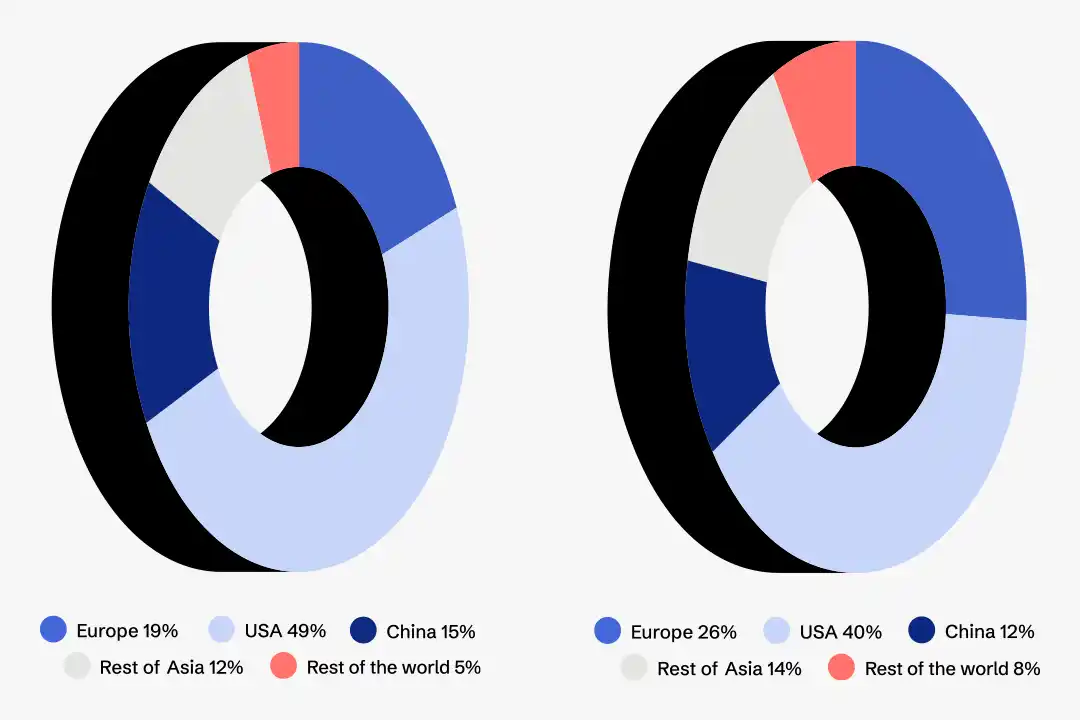
Left: VC investment seed stage per geography (company location) YTD 2023 (Q3). Right: Total VC investments per geography (company location) YTD 2023 (Q3)

Left: VC investment seed stage per geography (company location) YTD 2023 (Q3). Right: Total VC investments per geography (company location) YTD 2023 (Q3)
Even if many of the European VC market sentiments deteriorated further this year, the expectations for the next twelve months have improved. However, the confidence of fund managers in the long-term growth prospects is at an all-time low since 2018. This is largely explained by the current macroeconomic and geopolitical situation making both fundraising and exits challenging.
11 new European unicorns were born in the first three quarters of 2023, three of them in Q3.


11 new European unicorns were born in the first three quarters of 2023, three of them in Q3.
Zooming in on the Nordics, Sweden is starting to lose its dominance. The reason for this could be because the Swedish VC scene is more mature and most declines have been in later financing rounds. Instead Norway and Denmark have gained ground. Will the current climate be a reboot to a more even Nordic VC market, or will it scare off many new investors in the VC space? Time will tell. But a continuous cyclical development is the only thing we know for sure.

Most countries are back to 2019 levels of activity, with some exceptions like France (+37%), Denmark (+72%), Norway (+181%) and Italy (+57%), venture investment in H1 2019 compared to H1 2023.

Most countries are back to 2019 levels of activity, with some exceptions like France (+37%), Denmark (+72%), Norway (+181%) and Italy (+57%), venture investment in H1 2019 compared to H1 2023.
Activity levels same as in 2019
Most countries are back to 2019 levels of activity, with some exceptions like France (+37%), Denmark (+72%), Norway (+181%) and Italy (+57%), venture investment in H1 2019 compared to H1 2023.
3,4 trillion USD is the combined value of Europe’s tech ecosystem.
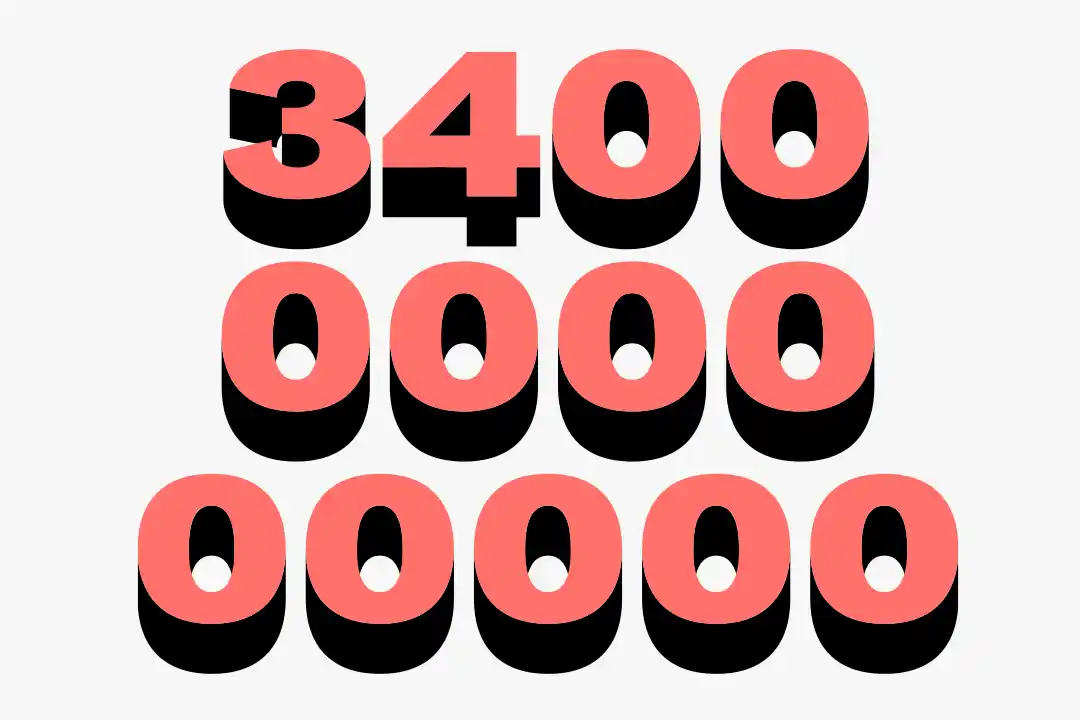

3,4 trillion USD is the combined value of Europe’s tech ecosystem.
11 new European unicorns was born in the first three quarters of 2023, three of them in Q3.
77 billion USD is the value of expected investment in European startups 2023 (well over the previous pre-pandemic record).
[Sassy_Social_Share]
We need to embrace and explore uncertainty
“We need to embrace and explore uncertainty”
Nathan Furr’s thesis is that uncertainty and opportunities are two sides of the same coin. And he’s going to give leaders in Schibsted 42 different tools to navigate a world of uncertainty.
Words by Ann Axelsson
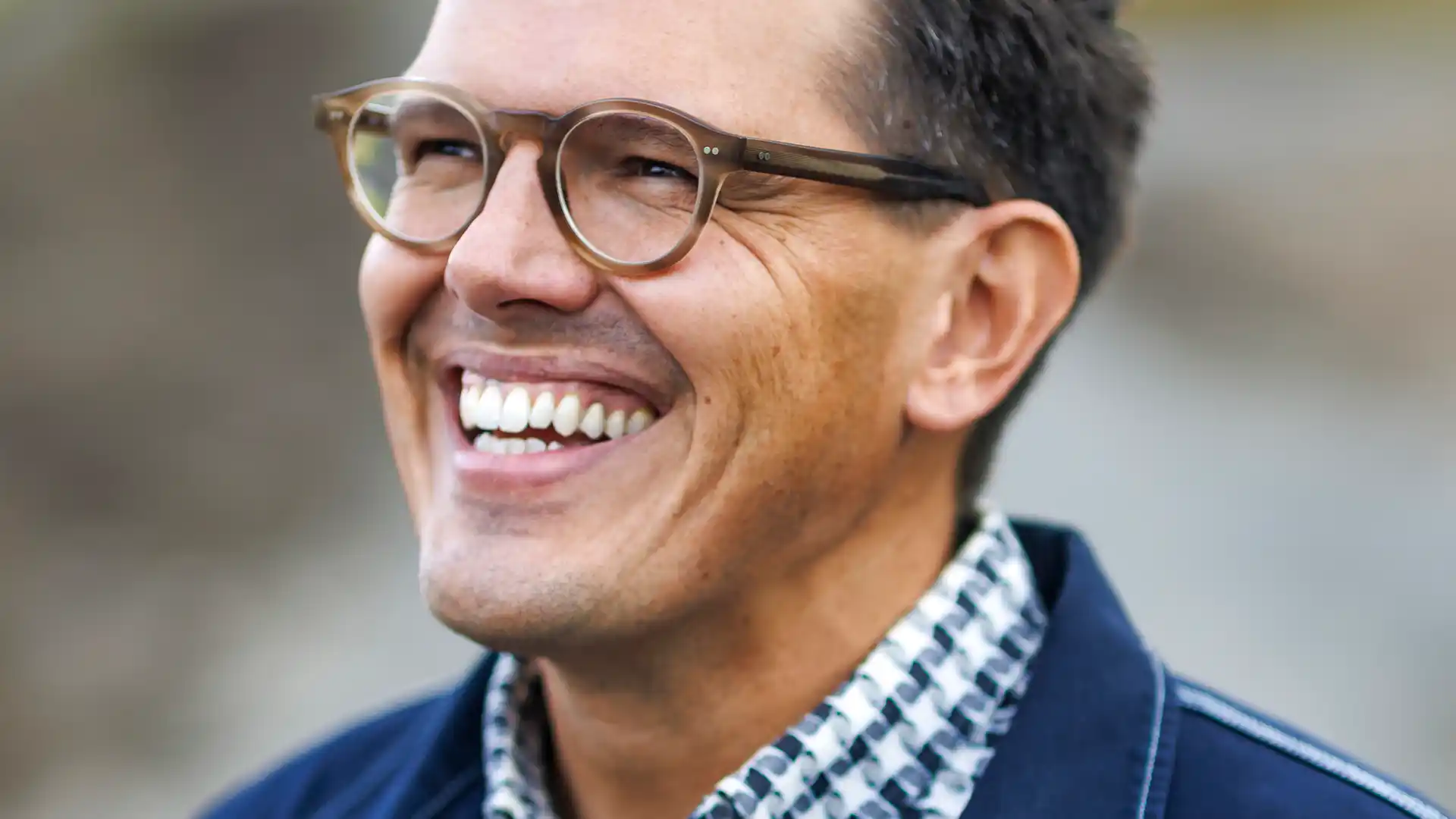
“We need to embrace and explore uncertainty”
Nathan Furr’s thesis is that uncertainty and opportunities are two sides of the same coin. And he’s going to give leaders in Schibsted 42 different tools to navigate a world of uncertainty.
Words by Ann Axelsson
“I strongly believe that we are missing a critical leadership capability in our modern world. The ability to face uncertainty and see the possibility.”
Nathan Furr is a Professor of Strategy at INSEAD and a renowned expert on managing in times of disruption and uncertainty. He’s also an author and co-author of several books. Now he’s leading a management program in Schibsted, using a framework he set up after years of working closely with startups, understanding their mindsets and how they handle risk and uncertainty.
And no doubt, we live in uncertain times. Choosing a path at a time when change is constant and happening fast can be very stressful. Nathan brings up generative AI as an example.
Confused with risk
“Uncertainty is when you don’t know all the variables involved. With AI we don’t know where it’s going to go. We don’t know how it will affect our careers or our lives. We don’t know what the future will be like.”
He also believes that uncertainty often is misunderstood and confused with risk – when you actually know the variables involved, you know the probability; you just don’t know the value you are going to get.
“Risks we can manage and control, but to handle uncertainty we need something different, we need to embrace it and explore it. Because if we see generative AI as a risk, we will probably avoid it and miss out on opportunities.”
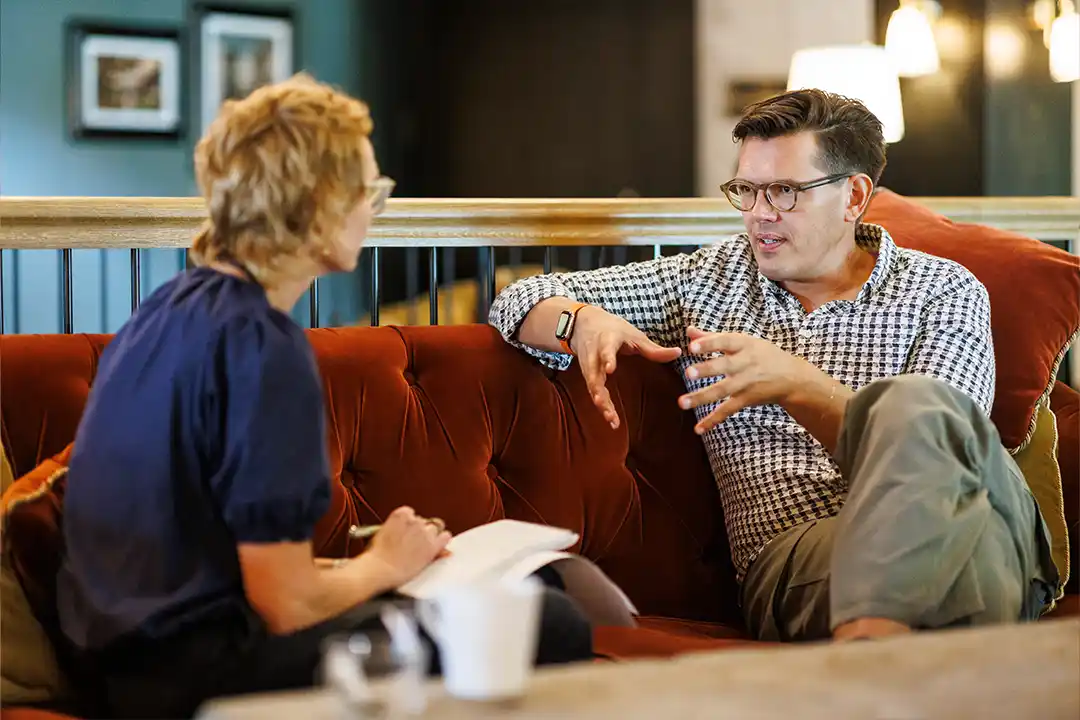
Nathan Furr is leading a management program in Schibsted, using a framework he set up after years of working closely with startups.

Nathan Furr is leading a management program in Schibsted, using a framework he set up after years of working closely with startups.
This is where the framework and the 42 tools come in. But perhaps even more important is the perspective that this theory is not something reserved for only your work life. That insight was pushed by Nathan’s wife Susannah Harmon Furr, who is an entrepreneur, designer and art historian.
Together, they wrote the book that serves as a guide to the framework, called “The Upside of Uncertainty.”
All parts of life
Susannah helped Nathan understand that uncertainty is incorporated in all parts of people’s lives and even if he speaks to leaders, it starts with us as people, as human beings.
“And she was so right. All that uncertainty, it fires in your brain. You feel it in your gut. And to help others through it, I really believe you’ve got to start with yourself.”
In the book, Nathan and Susannah prove that. They share some private stories about their lives and their family, times when uncertainty was fundamental and when the framework helped them see the crisis from a new perspective. Like when their son became very depressed in the aftermath of the COVID-19 pandemic, and they had to watch over and care for him. The tool they speak about is reframing.
“We reframed in that moment to focus on what we still had. And that was each other, the capacity to have him with us and give him the right treatment. Instead of focusing on the uncertainty.”
Reframing is one of four categories in the toolbox.
“We have this heritage from evolution that we tend to run from things we see as a loss or a threat. But when we see it as a gain, we run towards it. So, if you focus on the possibility side you trigger more of that positive momentum, and the tools in this category are about that,” he explains.
The three other categories are called priming, taking action, and sustaining. And with these in place, leaders will be better equipped to dare to explore new possibilities, according to Nathan.
Innovation capability
And that’s the whole point. To Nathan, leading in uncertainty is one piece of what he believes is a greater innovation capability.
“As the world becomes more dynamic, you’ve got to explore, and you have to innovate. And because I’ve been obsessed about what uncertainty is my whole career, I have also been obsessed with finding all the parts of the puzzle that lead to innovation.”
Some of those parts he has found are connected to behaviours, processes, culture, leadership and organisation. Things he will also go into during the course.
On a personal level, Nathan also struggles with uncertainty.
“It makes me really nervous.”
And, depending on personality, he acknowledges that some people will struggle a bit more than others to embrace his thesis.
“But on the other hand, the research is very clear – people can learn this and get better at it.”
[Sassy_Social_Share]

Ann Axelsson
Senior Product Manager, Strategic Communication, Schibsted
Years in Schibsted: 25
My favourite song the last decade: Paper Doll – John Mayer
